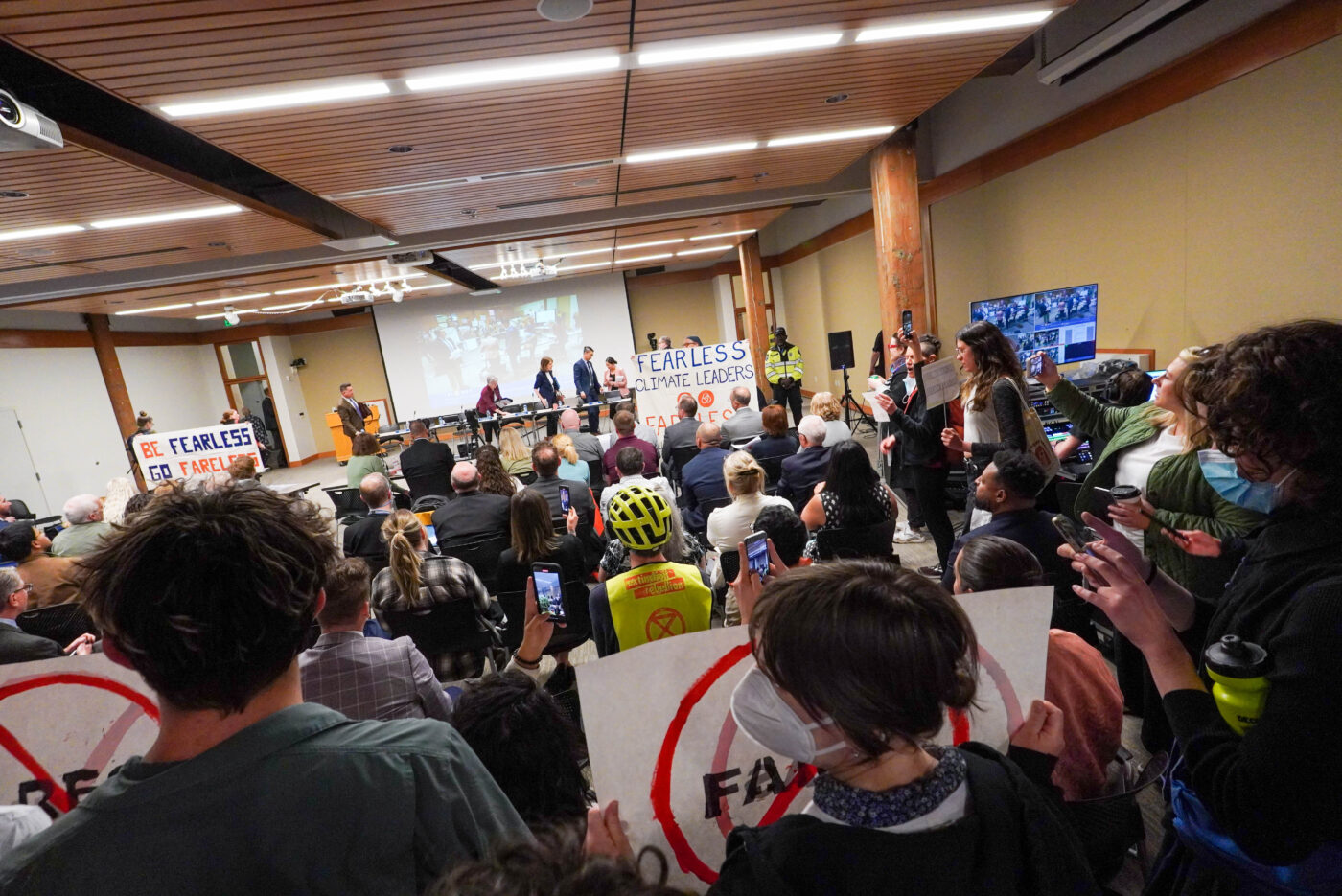
TriMet’s seven-member, unelected board of directors voted to enact a 30-cent fare increase at their meeting in downtown Portland today by a vote of 6 to 1; but not before a raucous crowd of protestors led them to adjourn the meeting several times and they ultimately finished the meeting behind closed doors with several security guards standing outside.
The banging of protestors’ arms against the walls of the room could be heard clearly in the livestream. “Cowards! Face us! Cowards! Come out!” they shouted.
A wide range of people — from high school students to working moms and retirees — who oppose the fare hike, say it’s a short-sighted fix to a larger, systemic funding problem, and its impacts will be felt most by the people who can least afford it. The increase and the aggressive fight against it, is set against a backdrop of a climate crisis, flagging transit ridership, and skyrocketing food and housing costs. For their part, TriMet says the increase will help them keep pace with operating expenses that have risen by 4.2% per year for the past decade. Without higher fares and the estimated $4.9 million per year that would come with it, TriMet says service would only get worse.
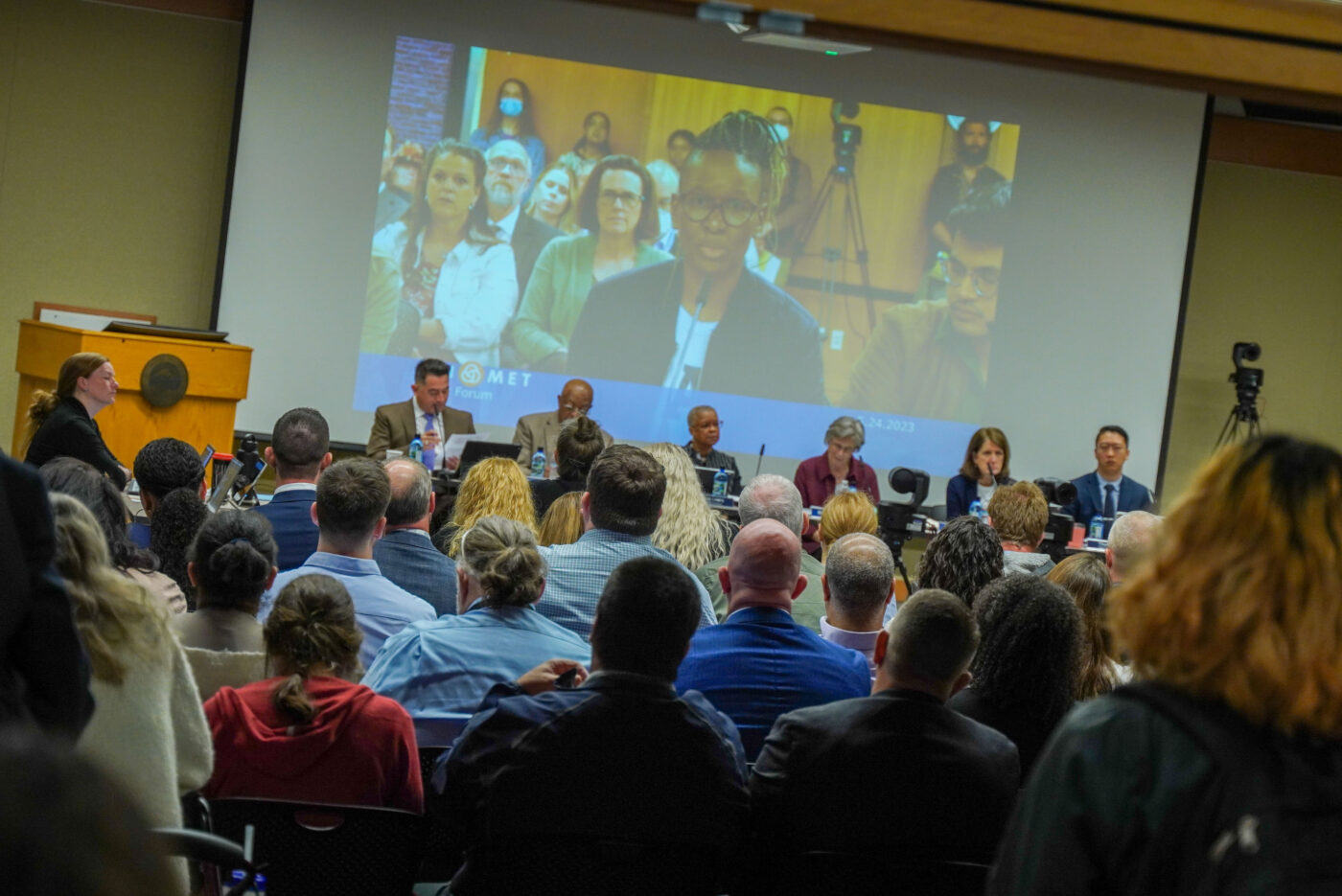
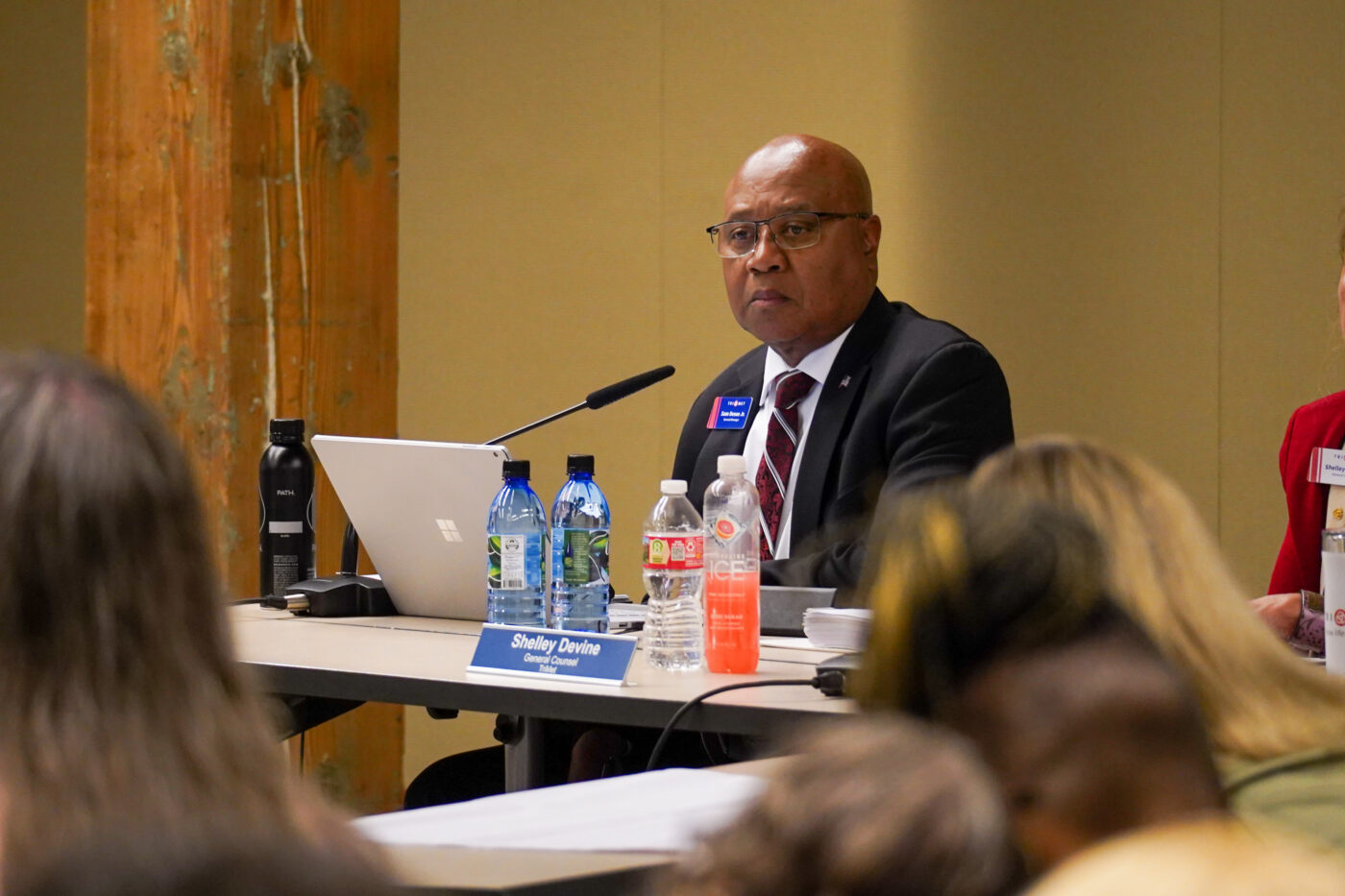

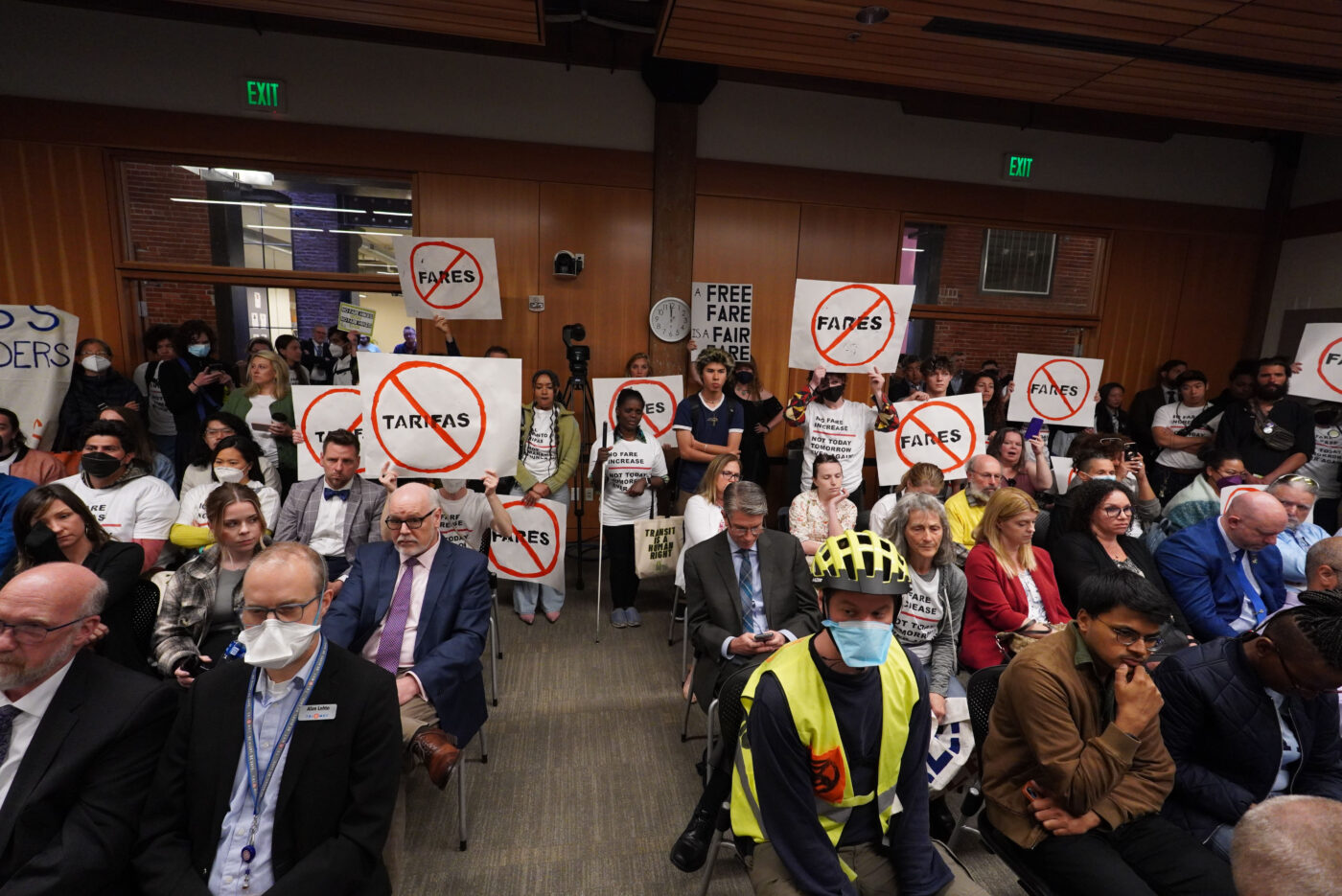
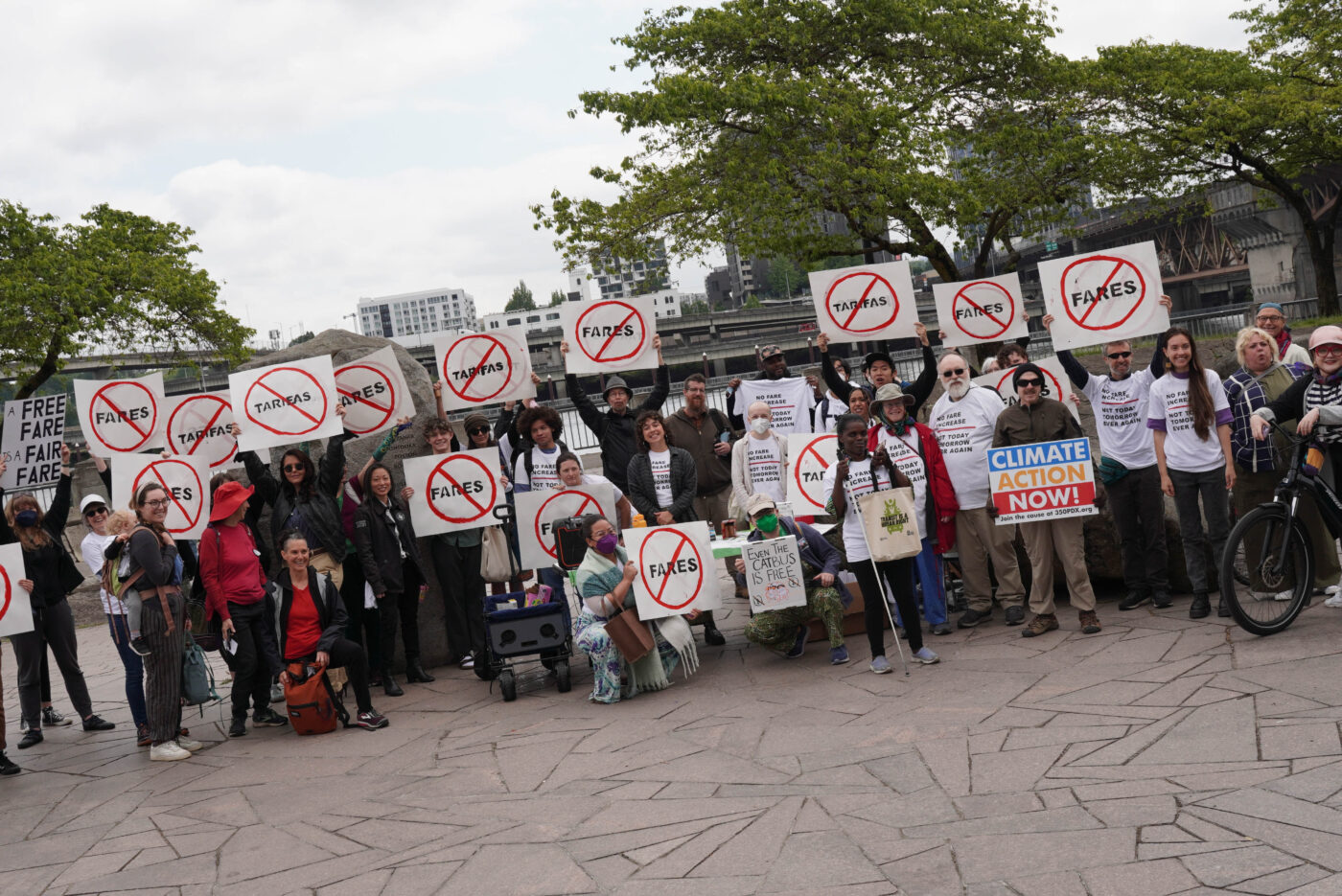
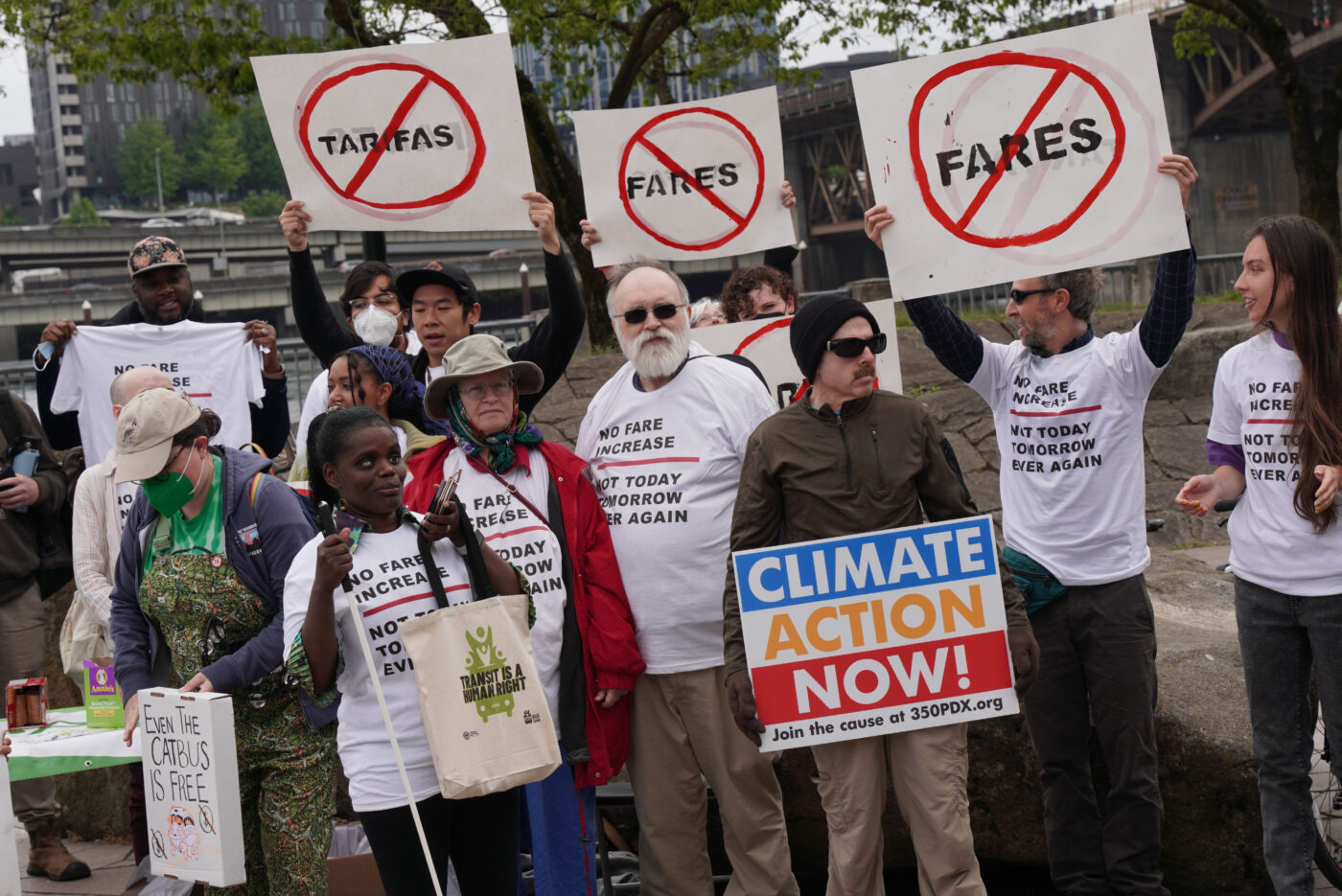
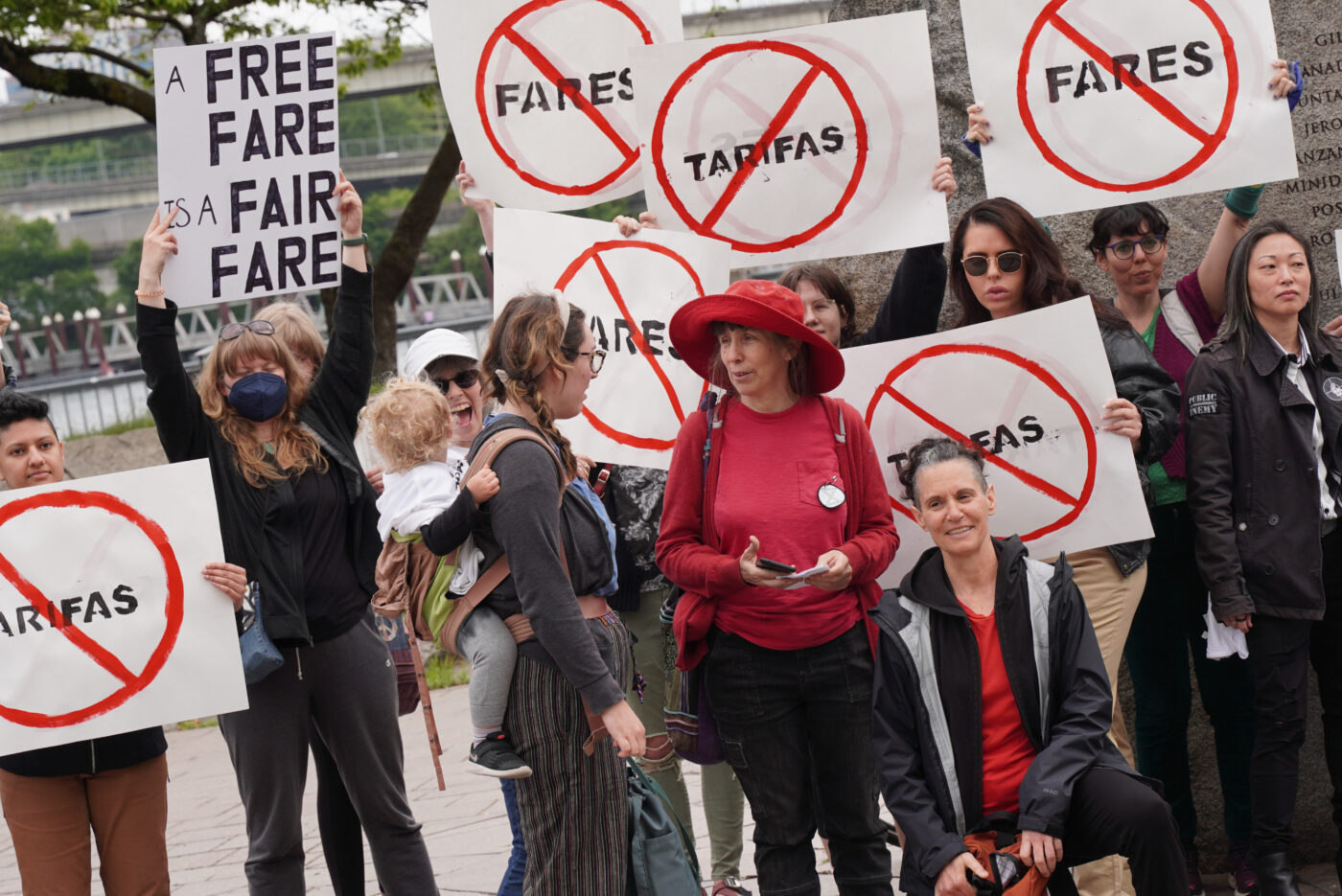
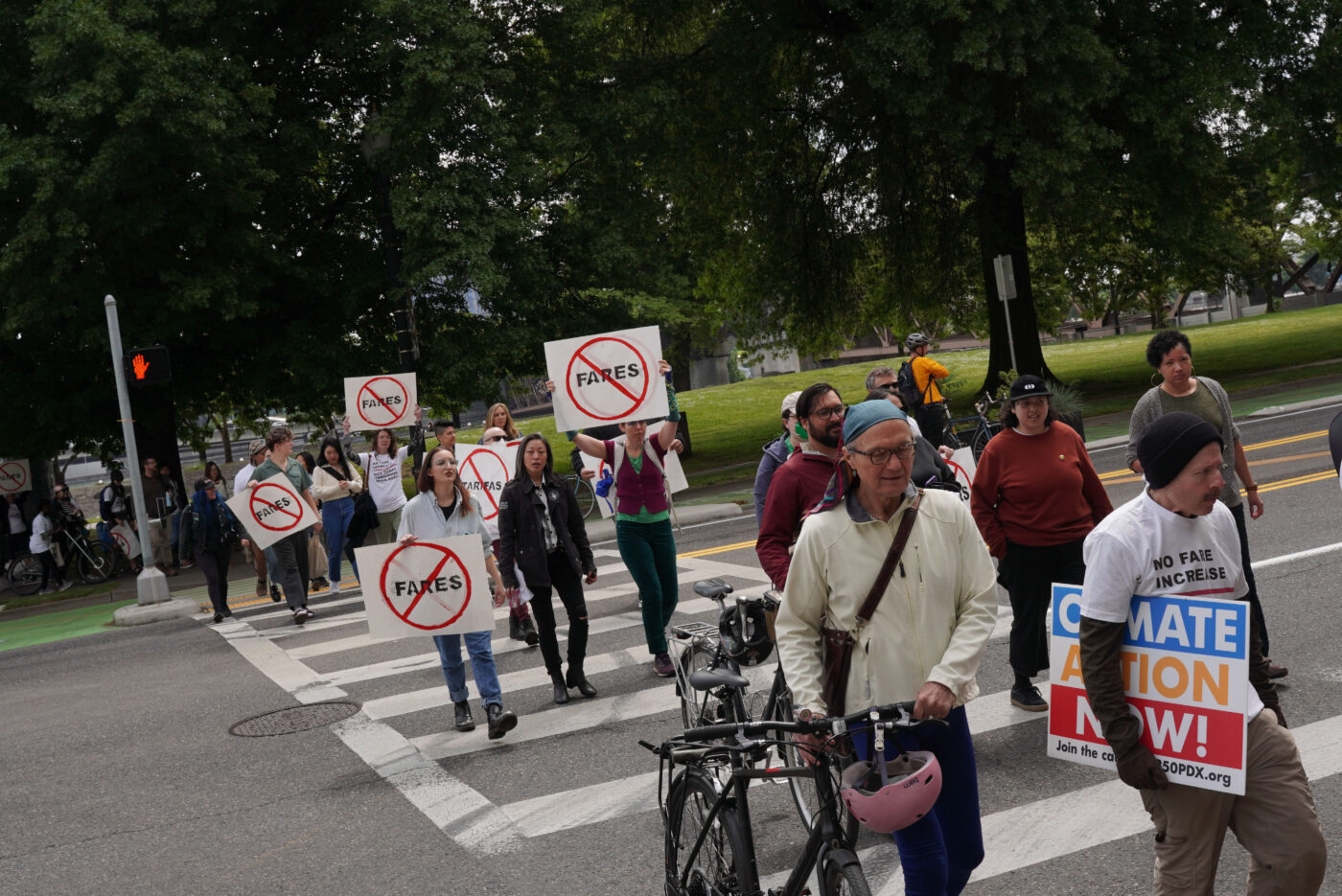
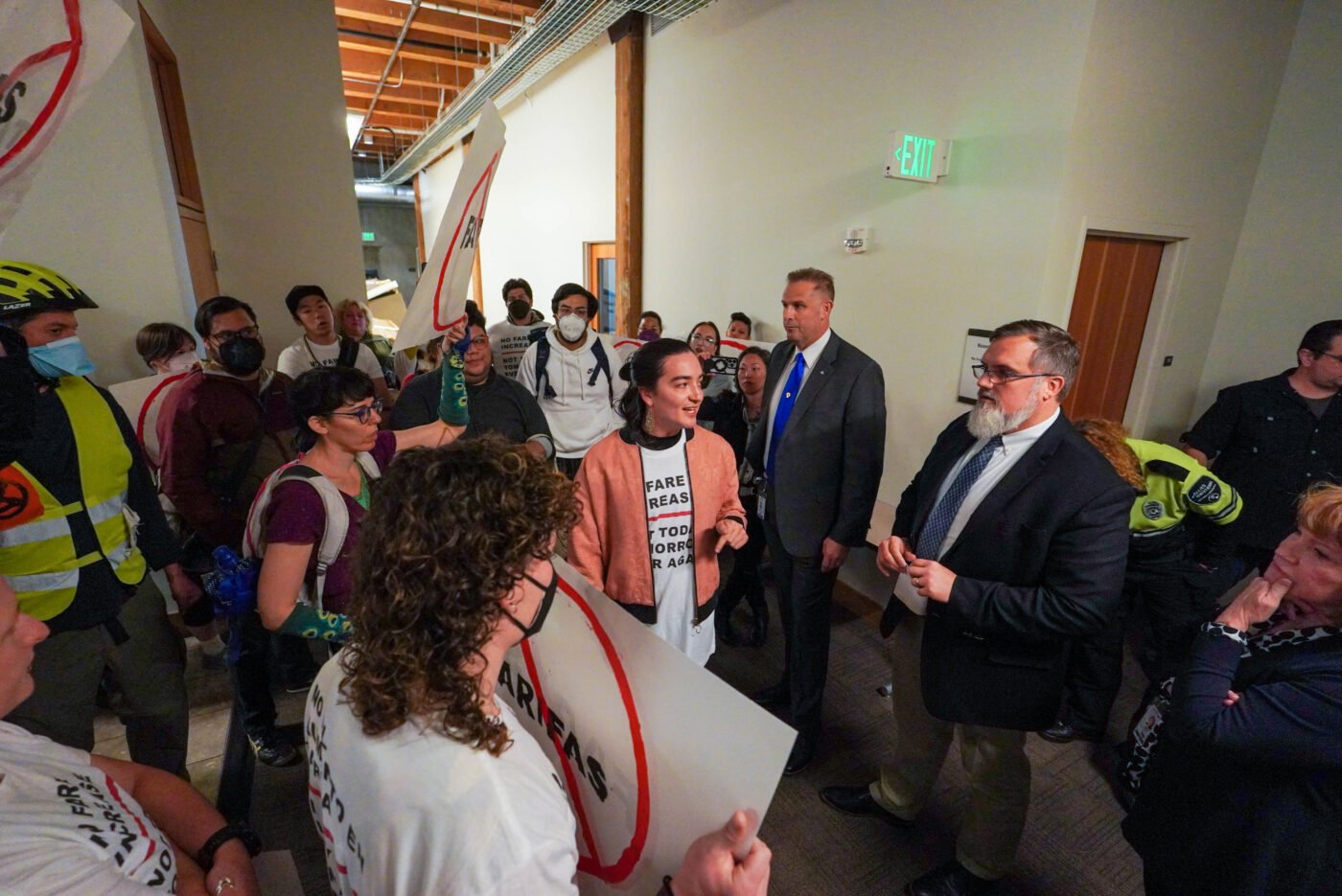
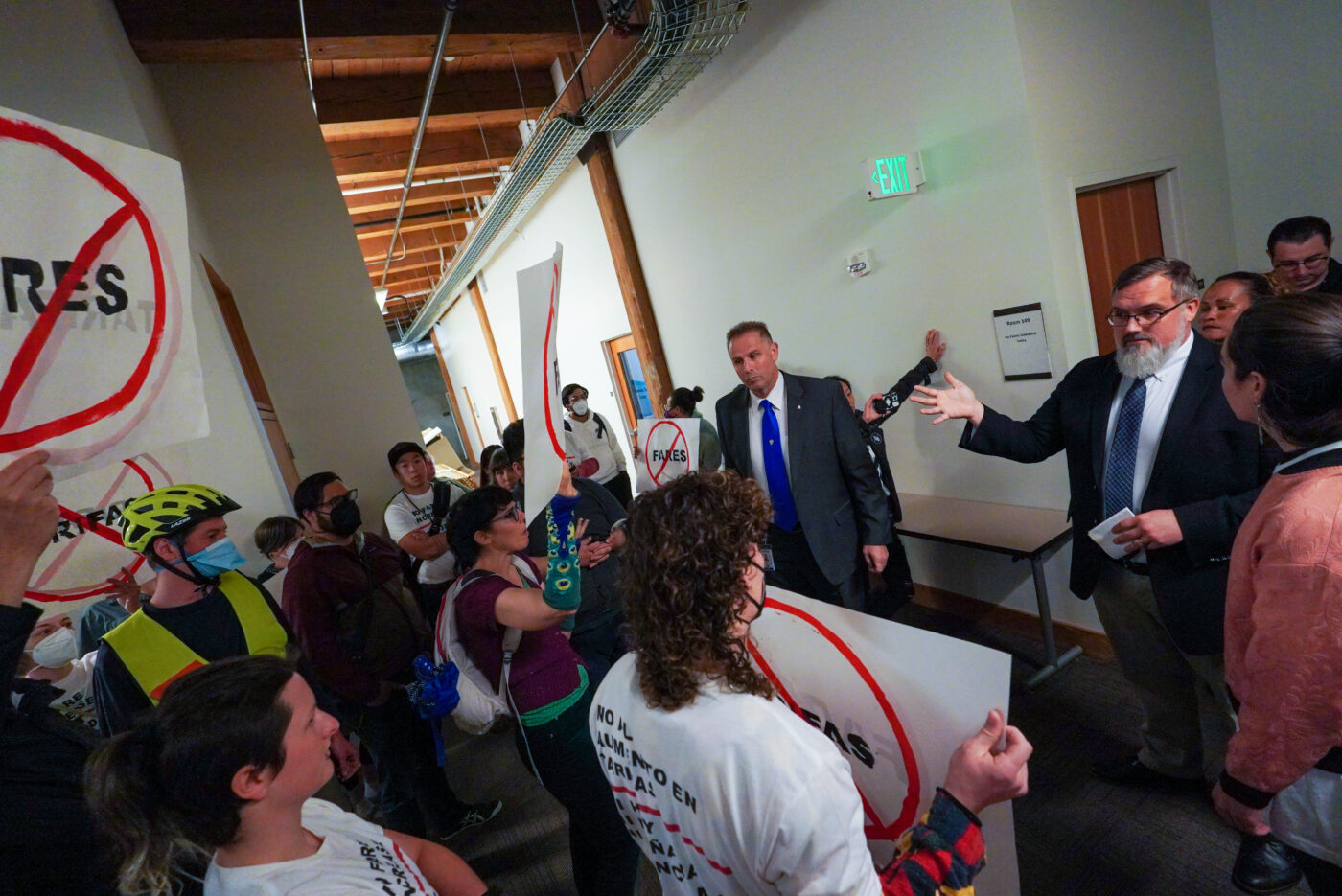
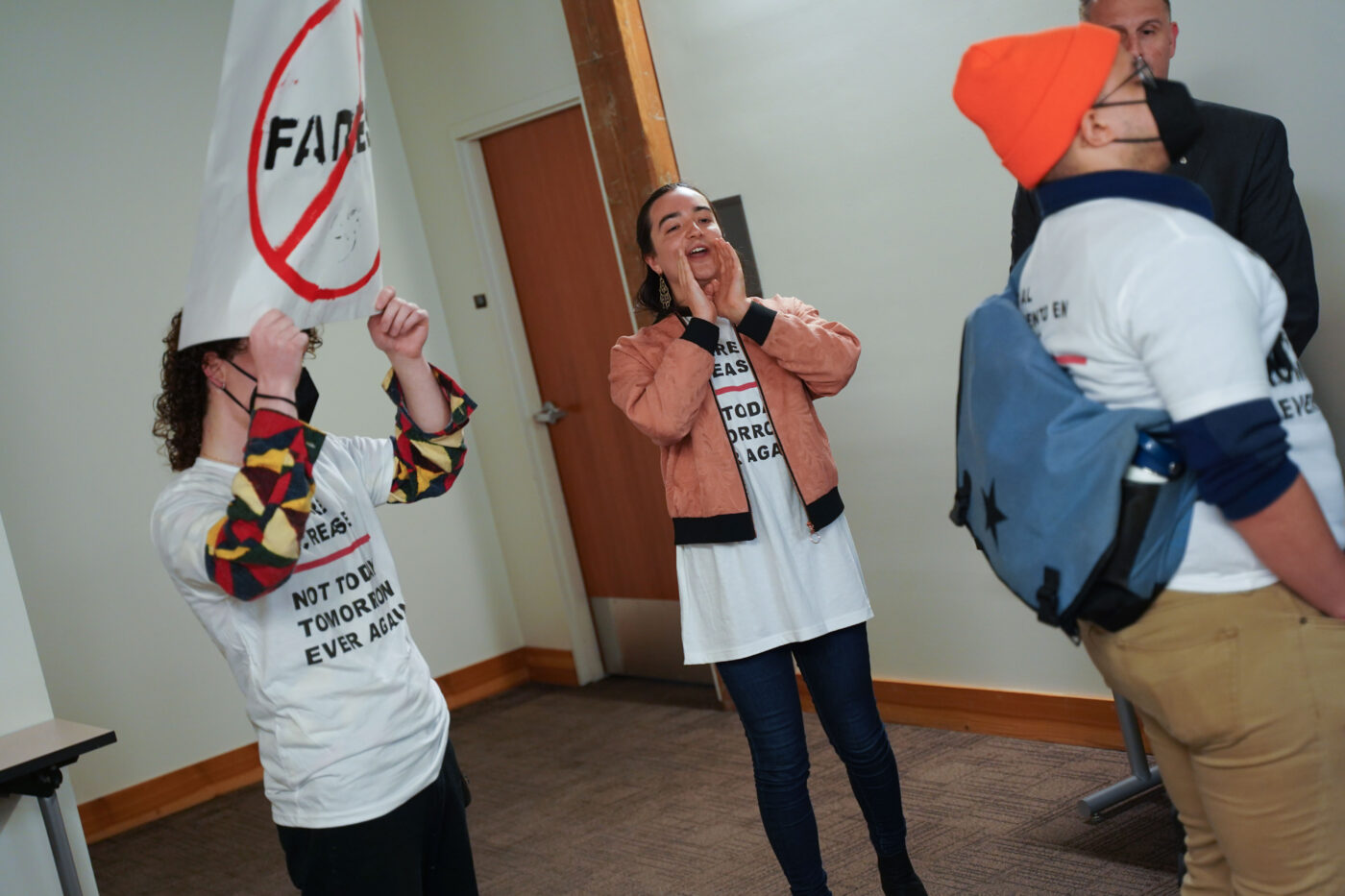
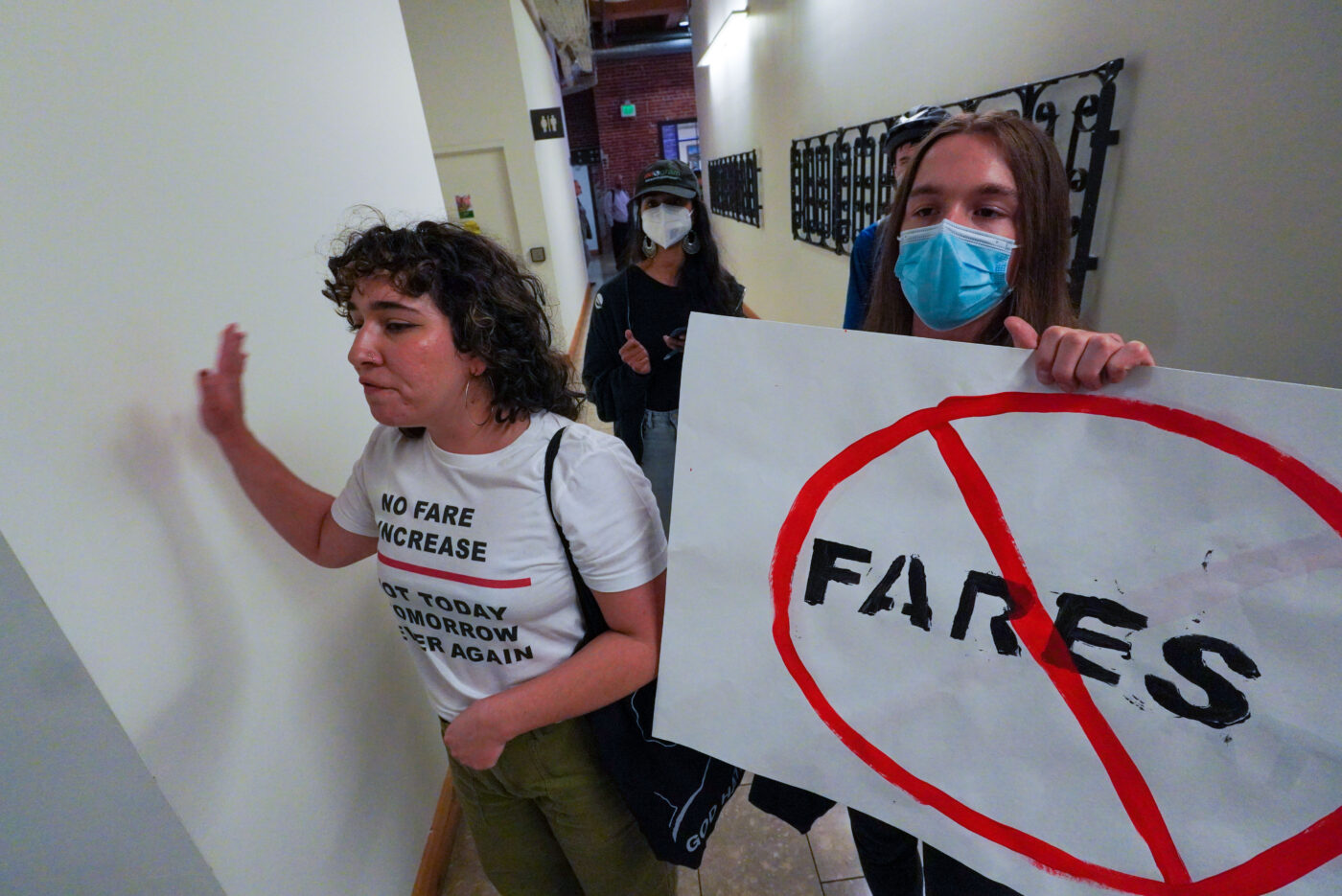
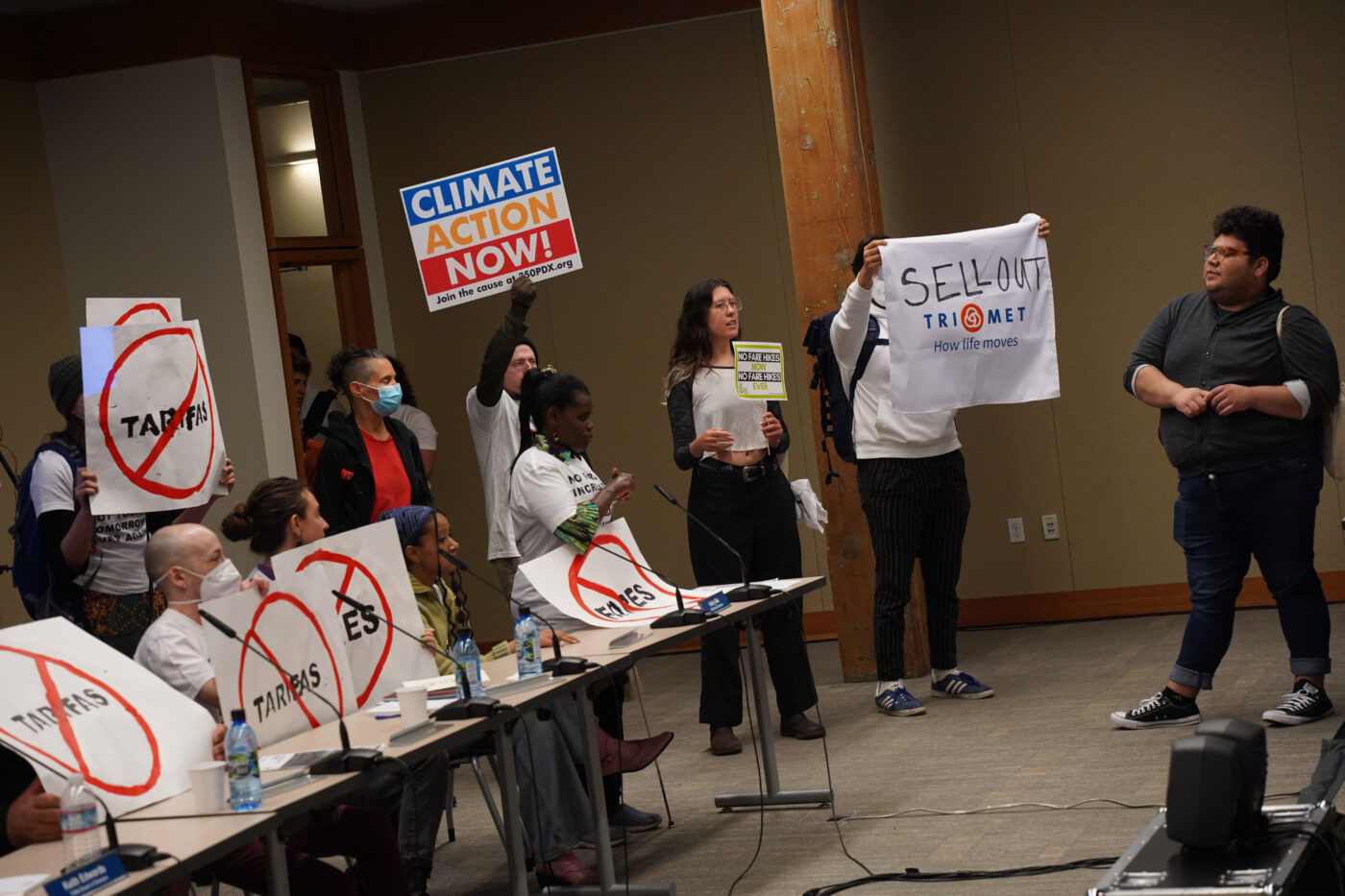
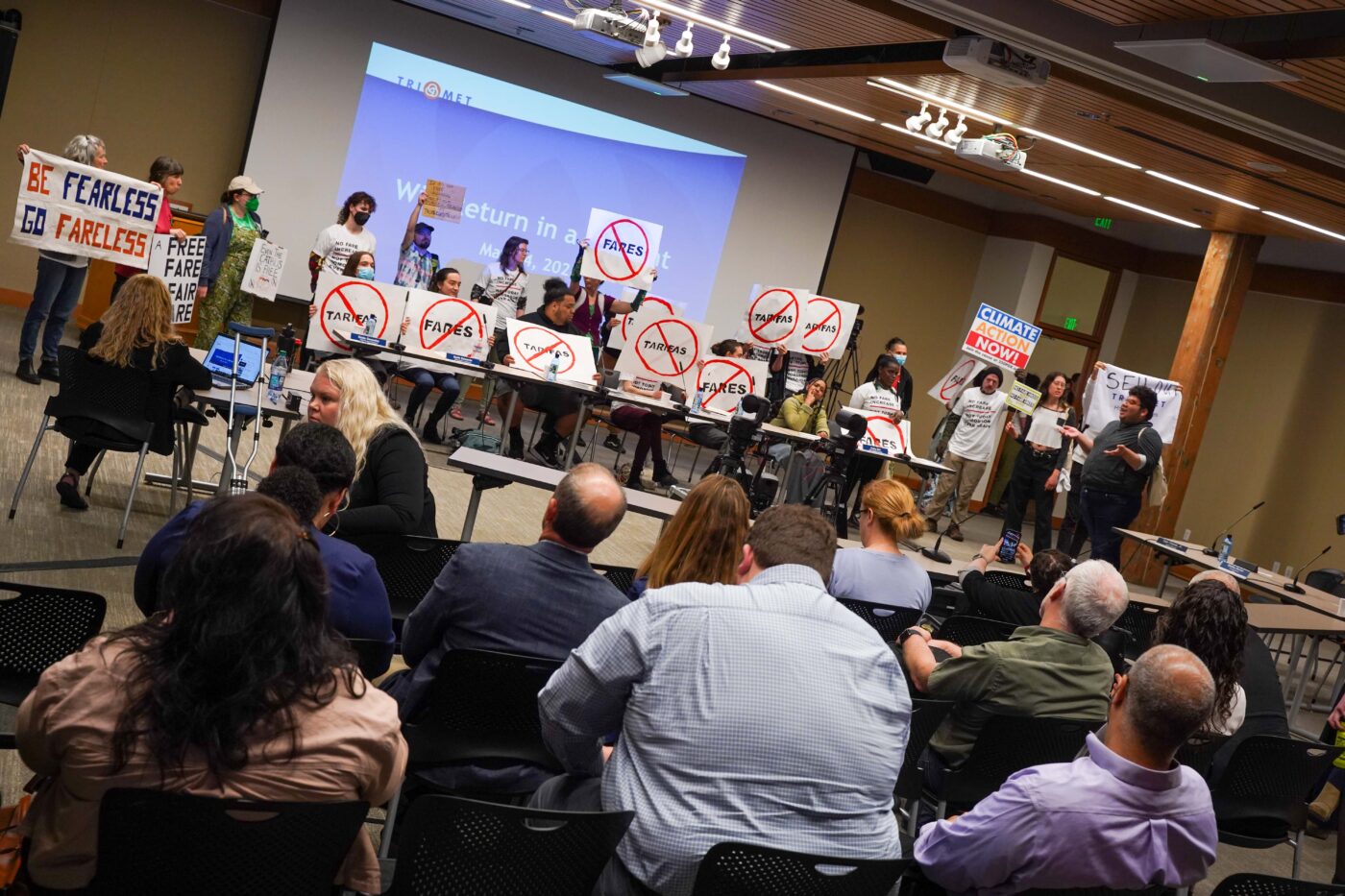
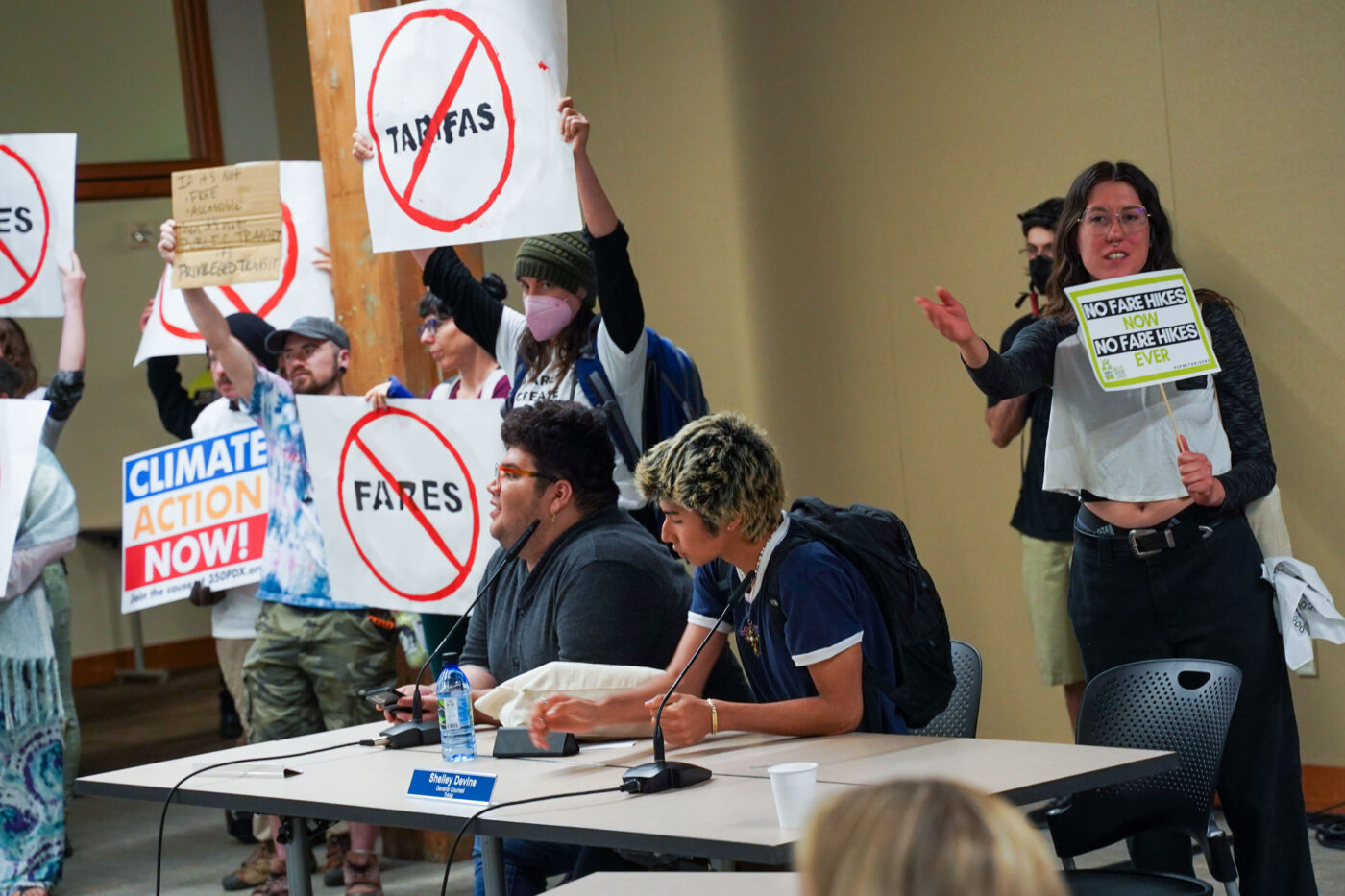
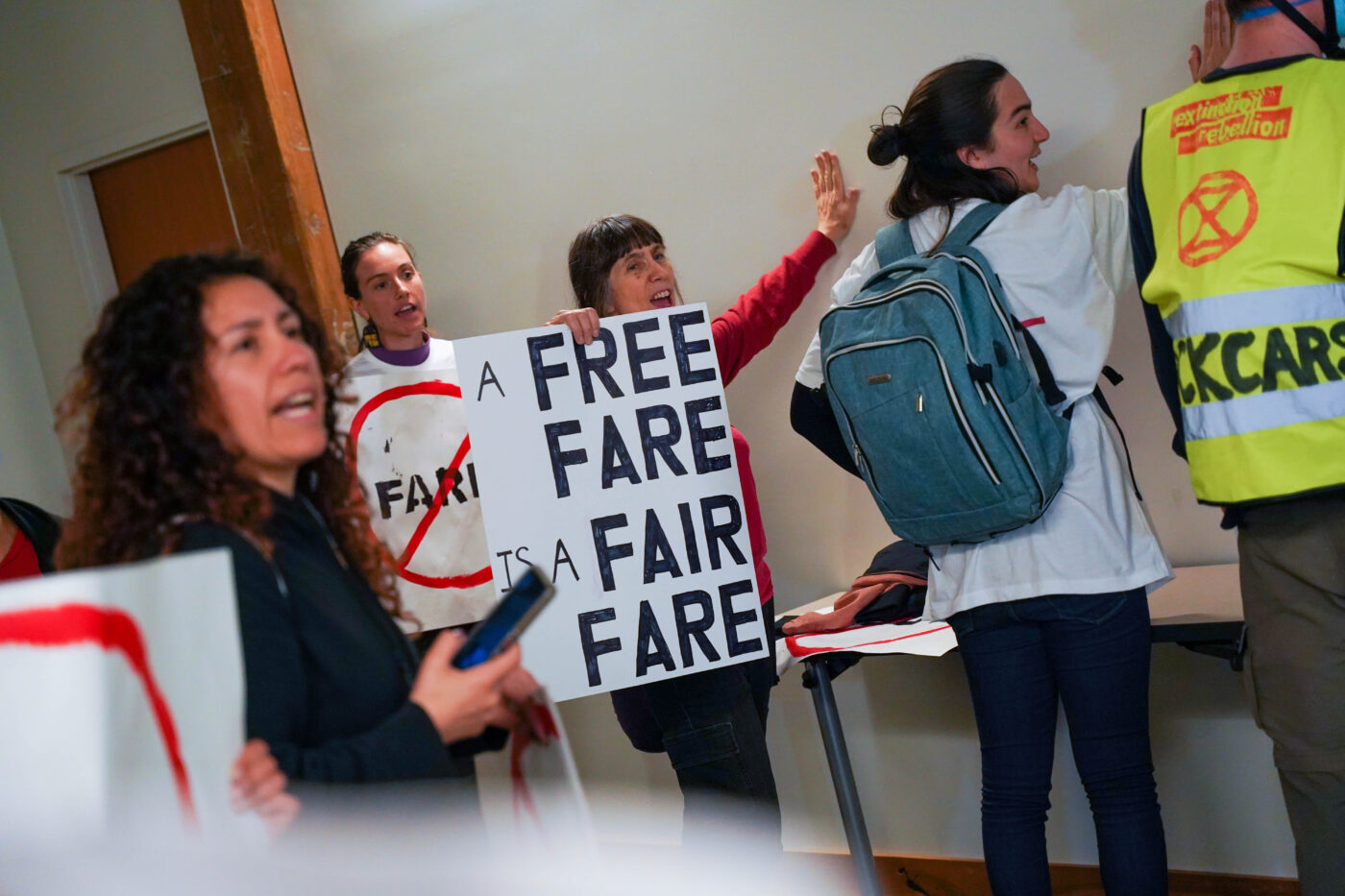
The meeting was held at the University of Oregon campus in Old Town. It opened with public testimony — much of it opposed to the fare hike ordinance (number 374) that was on the agenda. The first person to testify was Oregon State Representative Khanh Pham. “Unfortunately, this fare increase appears to be a temporary budget bandaid that ultimately hides the larger systemic problems that TriMet must begin to tackle to be the transit agency of the 21st century that we need,” Pham said.
Pham and many others (including TriMet board members) acknowledge that farebox revenue isn’t an ideal way to fund a strong transit system and that a new approach is needed. The approach many people said they want is for TriMet’s board to be more bold and aggressive in their pursuit for other revenue so that fare-payers aren’t subject to so much of the budget burden.
“As a transit board,” Pham urged in testimony she gave from her office at the State Capitol in Salem, “You have the opportunity to set the tone for a more assertive approach… a more aggressive approach to… plan a generational investment in public transportation.”
Transit advocates with OPAL Environmental Justice Oregon told the board that a fare increase would worsen public health, fewer people on transit, more carbon emissions, traffic deaths and social isolation. Several people who testified pointed out that TriMet’s own analysis showed that the fare hike would have a disparate impact on lower-income people and that a majority of riders surveyed said it was a bad idea.
Mercedes Elizalde with Latino Network urged the board members to work harder to find funding from other sources. “TriMet has successfully avoided more financial burden on riders for more than a decade. This isn’t a problem to solve, this as a success story to live up to,” she said.
Meanwhile, across the street from the meeting in Waterfront Park, several dozen people assembled for a protest rally. The rally was organized by OPAL and their Bus Riders Unite campaign. The rally-goers strategized, put on “No Fare Increase” t-shirts, held up signs and made speeches. Retiree Amanda Briles told me she’s ridden TriMet since she was 15 years old.
“I really like TriMet and I really rely on it. And now that I have less income I’m really concerned about fares going up,” she said.
Climate activist Guy Berliner, who could be heard chanting “tax the rich” throughout the day, said he thinks the burden of this fare increase should fall on wealthier people. “I’m tired of watching the planet be incinerated and I see this as another step in the depraved, nonchalant, feckless attitudes of bureaucrats… looking for ways to patch their budget that will not offend the people who have the resources that they need to disgorge in order to make public services functional.”
Asked what he feels the next step should be if the fare hike passes, Berliner said, “I think we need about 1,000 people here instead of 40 people. We need many thousands of people to descend on them and scare the living crap out of them. That’s the answer. That’s the only way that changes ever come about.”
Berliner, Briles and the rest of the protestors then massed and timed a march across NW Naito Parkway to the meeting at the White Stag Building just as the fare hike ordinance was to be voted on. Almost as soon as the ordinance was introduced, protestors who filled the meeting room began shouting their disapproval. Minutes later, TriMet Board President Dr. Linda Simmons and her colleagues got up and walked out of the room. This was the first of several recesses taken because Simmons felt the yelling from attendees was not compatible with an open, public meeting.
Once back from recess, TriMet General Manager Sam Desue shared his remarks and the shouts from audience began again. Slowly at first, then they gathered frequency as a TriMet staffer made a presentation about why they felt the fare hike was justified. As the staffer went through her slides, protestors offered live fact-checks and opinions in strong disagreement. When it was finally time to hear how each board member would vote, they got through three sets of remarks before Simmons called another recess.
Board Member Kathy Wai (a community organizer who represents Clackamas County), was the only member to vote against the increase. “I think this is a premature vote that will dampen the future of collaboration — and I mean real and true transparency and collaboration between communities that are going to be the most affected,” she said.
Here are a few more snips from Wai’s remarks:
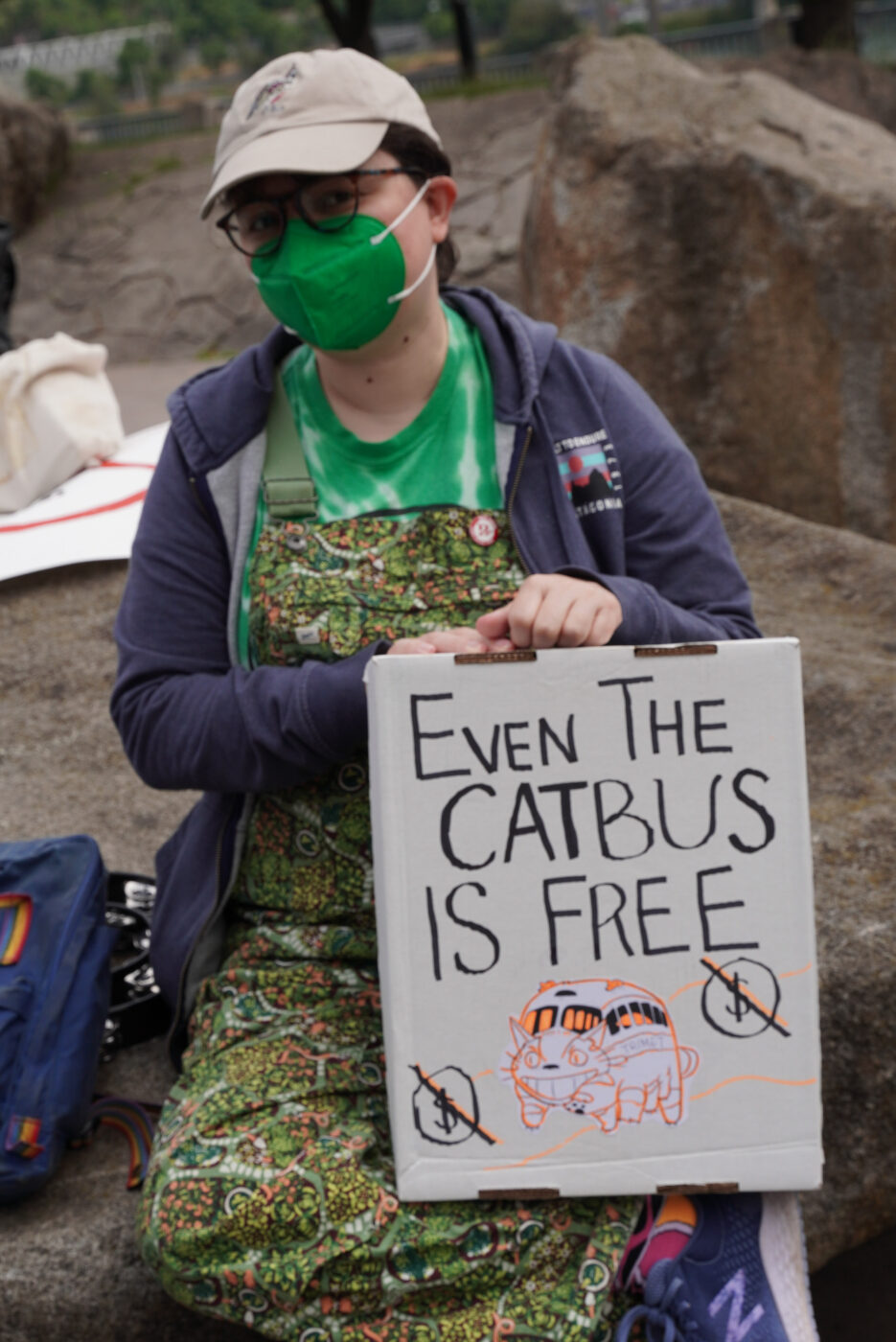

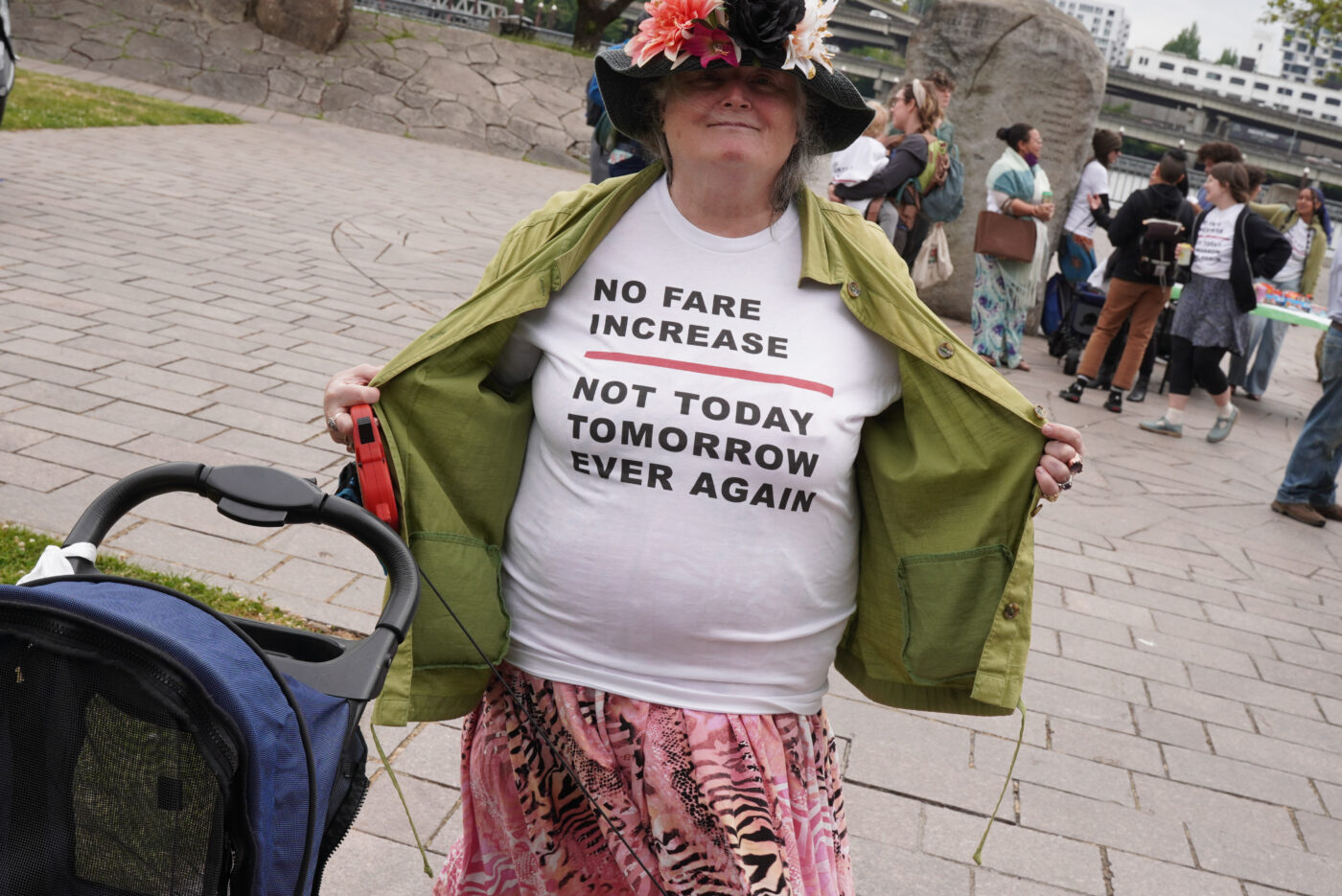
“I’m really, really concerned that this price increase is not going to do anything to address the stagnancy that we see in ridership… And I don’t think any of us are really realizing that public transit is a key problem-solver in the climate crisis that we’re currently facing… I feel like TriMet needs to be a major player in getting people out of their dang cars and onto our buses and our trains! I really feel very passionately that we need to be a bolder leader in addressing the climate crisis… There are a lot of issues I think in our current service and what we’re trying to deliver to the public, that I just feel like it’s not really meeting my expectations as a board member.
I don’t think that we need to do this right now. It’s not the right timing. And we need to really listen to the community, so I’m going to be voting with my heart and my conscience and I’m going to be a no.”
All of the other board members voted in favor of the fare hike.
Board Member Thomas Kim (Washington County) said he agreed with the testimony of Rep. Pham but that, “The current urgent financial reality is that until we can treat the funding issue, we need that band-aid… But I assure you that we will not be wearing the band aid forever.”
The boos and shouts from people in the audience picked up with each successive vote.
Board Vice President Lori Bauman (Southeast Portland) made her case by saying the new rate of $2.80 for a 1-day pass is equivalent to the 35-cent riders paid in 1969: “The ordinance simply keeps fares at the same level they were 50 years ago based on the purchasing power of the dollar.” That comment elicited so many shouts from the crowd that Board President Linda Simmons had to issue a warning.
“If you are disruptive or interfere with any of us talking,” Simmons said. “This meeting will be recessed and go virtual so that you won’t actually be present when the vote is taken.”
“So you don’t respect the people?!” someone shouted.
“You don’t respect our voice. We’re volunteers and we showed up, but we can’t do our job if you don’t let us speak,” Simmons countered, and then she got up and walked out with the rest of the board to a nearby room where the meeting continued online.
Protestors then marched down a hallway chanting, “Fare increases aren’t fair! Be fearless, go fareless!” and packed into a crowd right outside the closed-door room where board members holed up. Security guards stood in front of the door. After a few minutes a man walked out and tried to reason with the protestors, saying that they’d like to come back to the main meeting room to hold the vote, but only if protestors agreed to not “get too threatening” or push forward toward board members.
It quickly became clear that a truce could not be struck, so the board remained in the private room and beamed the meeting onto screens in the larger venue.
In the hallway, OPAL Executive Director Lee Helfend addressed the crowd:
“Did any of you vote for these board members?” they asked.
“No!” the crowded replied.
“Today we’re voting on a fare increase. Are any of you in support of a fare increase today?”
“No!”
“That is your vote. That is the vote that’s happening today!”
When it became clear the board would not return to the main meeting room, protestors walked to the front of the room and took the seats formerly occupied by the board. They held signs and there was an awkward tension as several TriMet staff and other members of the public who came to the meeting but were not part of the protest, were still in the audience.
A large group of protestors continued to chant and pound on the walls outside the private meeting room as the meeting continued on screens.
Board Member Ozzie Gonzalez was last to speak and he denounced the protestors. Gonzalez also accused some of them of being paid antagonists. “I’m really disappointed that right now we’re confusing democracy by having paid advertising brought to the public forum,” Gonzalez said during his official remarks. “I think we’re tarnishing the premise of democracy. And I believe that anybody who’s a tax-exempt organization needs to be very careful when they’re leaning into tax policy in this way.”
Gonzalez also had choice words for Portland Mayor Ted Wheeler, who sent a letter to the TriMet Board early this week urging them to not raise fares as part of his push against a “collective tax burden” he says is causing people to flee Portland. “This Monday morning quarterbacking happening from our public agency partners isn’t helping either,” Gonzalez said. “I’m severely disappointed in how absent they are when it’s time to come up with solutions, and how it’s some sort of political protection to tell us what they think we should be doing.”
The final act of the protestors was to wait outside the closed meeting room door for each board member to leave. Escorted by security officers, the board members were hit with yells of “Coward!” and “Shame!” as they hastily made their way out of the building.
It was a wild meeting that reveals many political and policy fault lines that we will certainly hear more of in the coming months and years.
For videos and a live play-by-play, check out my Twitter thread shared during the meeting.
Also note that Youth, Honored Citizen and Adult monthly and annual passes will not be increased. The increase for all other fares will go into effect January 1st, 2024. Learn more about the fare increase and TriMet’s budget on their website.



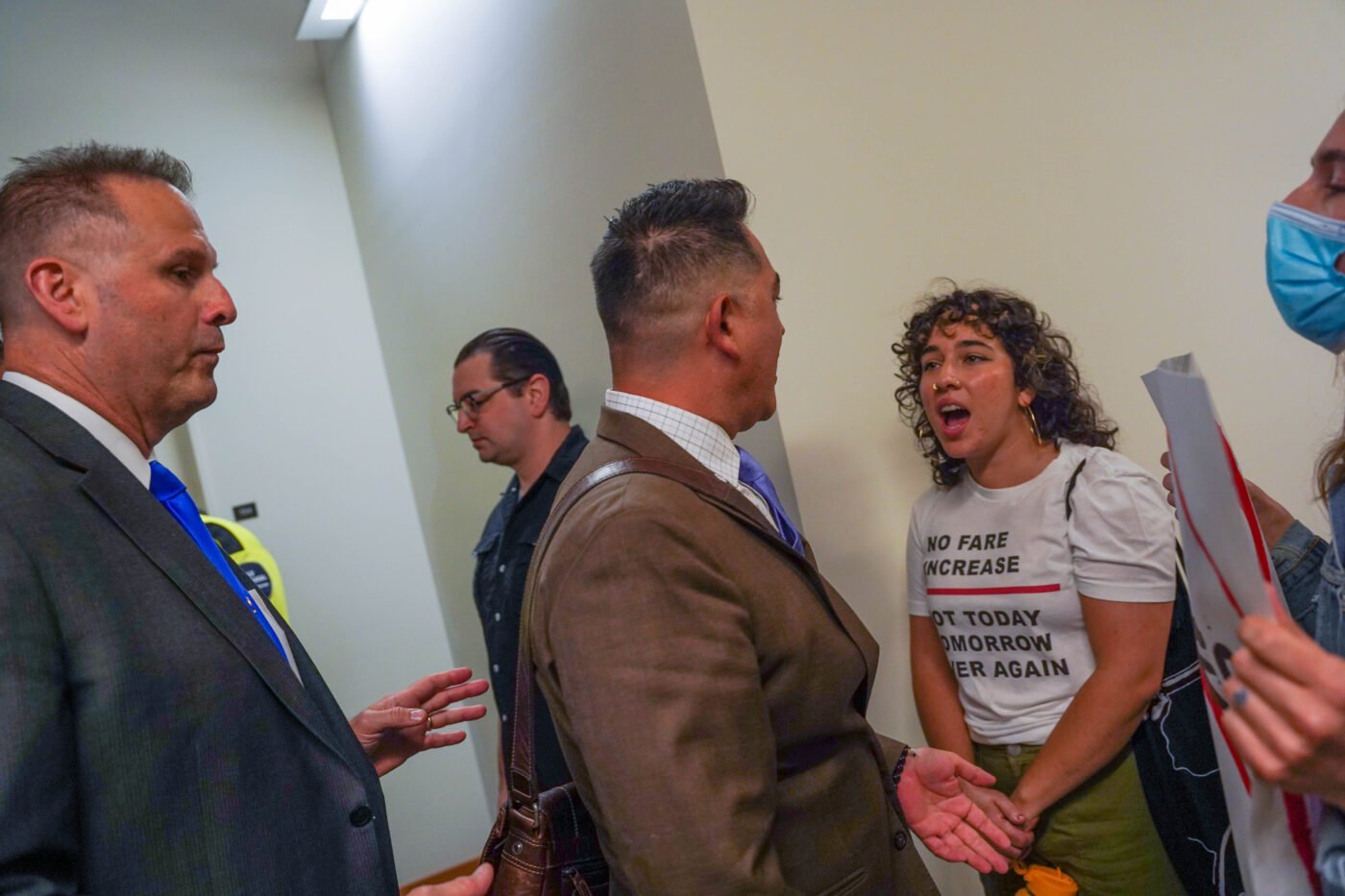
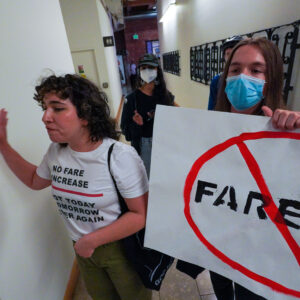


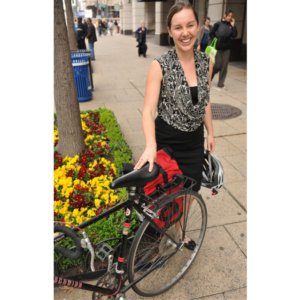
Thanks for reading.
BikePortland has served this community with independent community journalism since 2005. We rely on subscriptions from readers like you to survive. Your financial support is vital in keeping this valuable resource alive and well.
Please subscribe today to strengthen and expand our work.
Thank you for the detailed coverage of this important issue. I am very proud of the protesters. And disgusted by the vote and Ozzie G’s remarks.
Do you ride Trimet buses? Sounds like you don’t. It’s already free for anyone who gets on a bus and can’t pay. This fare increase will just compel people who have money to pay a little more. And frankly I’m willing to do it b/c Trimet needs all the help it can get right now.
Anything that will make public transit less of a s**tshow right now is what we need to be doing.
In your photos, the TriMet board members plainly have that pained look of “I’m not being paid enough to be here and take this abuse”.
Let’s say just for argument sake that the board decided to vote against the fare increase – how easy would it be for TriMet management or the governor’s office to override that vote and impose the fare increase anyway?
Neither of those are legal. The Trimet board is literally the final decision maker for Trimet fares.
It would be a very unusual board if they actually had such authority given that they aren’t directly elected by the voters, but instead appointed by the governor. So whoever appoints the board can’t simply force everyone (or a majority) to resign and replace them with other people who will vote the way the appointer wants them to? Or veto their decisions?
Does the board write their own bylaws or does some other authority? If the latter, then that body or person has the effective legal power to veto board decisions by simply amending the board bylaws – it happens in other communities all the time.
The governor has no veto, but she can replace the board if she wishes. The board writes its own bylaws. You can dig into their enabling legislation here: https://www.oregonlegislature.gov/bills_laws/ors/ors267.html
Thank you Will for this link. It’s an interesting read.
Everyone serves at the pleasure of the governor.
Trimet can impose a property tax and a tax on net business income if it so wishes, as well as the current payroll tax, and borrow money, issue bonds, charge fares, and so on. Not sure about sales tax.
267.615 Financing methods. (1) For the purpose of performing any of the powers conferred by ORS 267.510 to 267.650, a transportation district may use any of the following methods of financing:
(a) Service charges and user fees collected under ORS 267.570 (1)(d).
(b) Levy ad valorem taxes under ORS 267.620.
(c) Use of a revolving fund as authorized for mass transit districts under ORS 267.310.
(d) Sale of bonds under ORS 267.630 and 267.640.
(e) Levy of business license fees as authorized for mass transit districts under ORS 267.360.
(f) Levy of a tax measured by net income as authorized for mass transit districts under ORS 267.370.
(g) Levy of a tax measured by employer payrolls as authorized for mass transit districts under ORS 267.380 and 267.385.
(h) Acceptance and use of any contributions or loans from the United States, without limitation by any other provision of ORS 267.510 to 267.650 requiring approval of indebtedness.
(i) Any combination of the provisions of paragraphs (a) to (h) of this subsection.
(2) A district shall not use any method of financing authorized under subsection (1)(c) to (g) of this section without first obtaining authorization at a properly called election held for that purpose. [1975 c.737 §2; 1981 c.512 §1]
267.620 Power to levy taxes. (1) A district may levy annually an ad valorem tax on all taxable property within its boundaries not to exceed in any one year one-half percent (0.005) of the real market value of all taxable property within the boundaries of such district, computed in accordance with ORS 308.207. The district may also annually assess, levy and collect a special tax upon all such property in an amount sufficient to pay the yearly interest on bonds previously issued by the district and then outstanding, together with any portion of the principal of such bonds maturing within the year. The special tax shall be applied only in payment of the interest and principal of bonds issued by the corporation, but the corporation may apply any funds it may have toward the payment of principal and interest of any such bonds.
(2) Such taxes shall be levied in each year and returned to the county officer whose duty it is to extend the tax levy by the time required by law for city taxes to be levied and returned. All taxes levied by the district shall become payable at the same time and be collected by the same officer who collects county taxes and shall be turned over to the district according to law. The county officer whose duty it is to extend the county levy shall extend the levy of the district in the same manner as city taxes are extended. Property shall be subject to sale for nonpayment of taxes levied by the corporation in like manner and with like effect as in the case of county and state taxes.
(3) In taxation a district may classify property on the basis of services received from the district and prescribe different tax rates for the different classes of property. [1974 c.9 §12; 1991 c.459 §366]
I don’t believe they get paid anything to be on the board.
It’s a volunteer board. They definitely “don’t get paid enough for this s&%!”
TriMet is in a tough spot. Many people in the metro wouldn’t take it even if it were free solely based on how bad the service is (time wise, not driver wise).
This is the result of three decades of investing in commuter trolleys to downtown at the expense of everything else. TriMet is burdened by the MAX system and have a chicken and egg situation of how to attract enough riders to be solvent without having the money to expand service to the level that is needed to attract riders.
The fetishization of trains by the urbanist crowd has really screwed us for the near future.
I’ve been outspoken on this before and couldn’t agree more. I still don’t see a single advantage that a streetcar or light-rail system has over an express bus system.
Done correctly, bus rapid transit can have the same capacity as light rail (because more buses can be run per unit time) without the multitude of problems that arise from rail transport (including but not limited to: the presence of single-point failures for the entire system, lack of flexibility in future route changes, and ease of fare-evasion). And yet all TriMet ever wanted to do, until very recently, was invest in its toy trains at the expense of adequate BRT and local bus service. It’s no wonder that nobody takes transit.
The big advantage light rail has over buses is that a lot of money sloshes around the trough for cronies to take in. I cant say this definitively, but it sure seems like light tail only exists for developer profits and that its a giant, legal pyramid scheme that works just fine as long as it can keep getting federal grants.
Just imagine if the $10 billion spent on real-estate-rail had been spent on social housing…
People like me (and plenty of my friends) don’t take transit much now because it’s often dirty, has lots of sketchy people and feels unsafe. Until those issues are fixed it doesn’t matter if it’s trains, buses or polka dot hot air balloons, many will continue to avoid transit.
True dat, Yolanda. The 30 cents will help to pay employees to clean the buses. We need you back on the bus!
“I still don’t see a single advantage that a streetcar or light-rail system has over an express bus system.”
Trains require fewer drivers than buses moving the same number of people, and probably use less energy.
Now you know two!
Good luck getting TriMet to plan an actual BRT service.
Also, perfectly planned BRT is still lower capacity than meh-ly planned light rail. The idea that you can run more buses per unit time on a BRT line than a light rail line is entirely dependent on the lines themselves. Most parts of the MAX system run far (far) below theoretical maximum capacity – but system wide we are still relatively close to capacity due to the Rose Quarter/Steel Bridge bottleneck – a frankly easily solved problem (conceptually at least).
A hypothetical MAX service on just one trunk line (say, Goose Hollow to Hillsboro) would only be limited by the signalling system. In this case, you could comfortably run a train every 5 minutes and with a max passenger capacity of ~300 passengers/train be moving 3,600 people per direction per hour. An equivalent BRT line would have to run a bus every 1 min 40 seconds (at 100 people/bus for an articulated) to reach the same capacity. And considering that the rail line here could be comfortably doubled in capacity at just the cost of expanding platforms (which wouldn’t be too expensive outside of the Washington Park station), it’s hard to imagine a BRT line beating that.
There are legitimate drawbacks to rail service – especially in mixed traffic. But there are so many obvious advantages that if you can’t see them I have to imagine you aren’t looking. Capacity, durability, and permanence alone make rail a much better investment for a city
Sigh…5 minute headways are not something only LRT can do.
For example: the G (orange) line in LA has 4-5 minute headways during peak hours and is fully electrified. It also can use 82 foot buses if greater capacity is needed.
Did you read the comment you are responding to? The whole point is that trains can offer higher capacities. That G Line bus has a max capacity of somewhere around 100 passengers. A Red Line train in LA has a capacity of something like 500-700 passengers.
The 99B in Vancouver runs on as little as one minute headways in peak hours, but still has a lower theoretical capacity than the Canada Line since even the dinky trains they run can hold more people and board more efficiently.
An 82 foot articulated bus has a capacity of up to 300 people. A law was passed that approved these buses for the G line:
https://www.latimes.com/local/political/la-me-pc-gov-brown-on-sales-tax-increase-for-l-a-county-20150917-story.html
Right, but LA Metro does not own any 82 foot articulated buses. The New Flyer XE60s on the gold line have a stated passenger capacity of 119, which is less than the oldest of the Portland Streetcars (the Skoda 10T at 157) and MAX trains (the old Type I Bombardiers at 166).
Trains are (in a vacuum) more efficient at moving large numbers of people than buses. There’s a reason that all of the most economically productive cities in the world have some sort of grade separated rail transit service.
Where did I challenge this? Metro systems make sense in large dense cities. Portland is a low-density city and much of it looks like a suburb.
That’s still half of a 2-car LRT. In Seattle and LA, they can run 4 car trains capable of 1000-1400 people. The single most expensive part of public transit operations is the driver.
I was responding to a Blumdrew’s comment that used ~300 passengers/train as its baseline — hence my comment about 82 foot buses that can have ~300 passengers/bus.
And nowhere in my comment did I suggest that BRT should replace all LRT. I road the metro to school as a kid and have a lifelong affection for dedicated track LRT systems.
Thanks for clarifying that you don’t read comments before replying to them. Drew specified that a brt system would need a 1:40 headway to match the capacity of an LRT system with 5 minute headways. With a vehicle such as LA’s G line uses, which has a capacity of 131 passengers, a headway of 2:20 is needed to match the LRT that runs every 5 minutes. Importantly, that requires more than twice the number of operators.
Anecdotally, BRT systems take longer to load to crush loads than rail systems do. I’m not sure I have experience with a 3 door brt vehicle, but I’d think that would be inherent to rubber tire systems, where the internal layout needs to accommodate wheel wells, impacting circulation. That means that, generally speaking, rail modes perform better in dense employment districts, universities, and arenas. I certainly agree that brt systems have their place but it’s as absurd to say that brt is always preferable than it is to say that lrt is always preferable.
Nice strawman.
My somewhat flippant ten billion comment referred to the green, yellow, and orange lines which all have far lower ridership than Trimet’s hopelessly optimistic estimate. I think a green, yellow, and orange BRT would have been preferable in these cases.
It’s easy to make your argument after we’ve gone through a 3-year pandemic and gutting of our downtown. They were all built during a different time period and forecasts are always going to change due to unforeseen events.
The blue line is actually a great example to look at when comparing BRT and LRT costs. Since a huge portion of it (I-84 and west hills sections) are on expensive, dedicated ROW. BRT on dedicated ROW costs nearly as much as LRT. I think your beef might be with dedicated ROW, not so much the mode itself.
https://www.thetransportpolitic.com/2011/05/25/the-silly-argument-over-brt-and-rail/
https://www.researchgate.net/publication/325527105_Apples_to_apples_Comparing_BRT_and_light_rail_while_avoiding_the_BRT-Lite_trap
Since no one else mentioned it the other advantage of the streetcar and light rail over an express bus system is development. The streetcar specifically was to encourage development along it’s line and it succeeded at that. It’s not meant to be a fast and efficient source of transportation if it was it would be grade separated.
If it has multiple stops along dreamed-of mass housing, then grade-separated (for safety, primarily, not for speed in metro areas) or not, it will be slow, as well as remaining confined. If it’s a natural fit, fine.
Ugh, where to begin with all this nonsense….
1. The “fetishization” for rail comes from multiple directions. Per rider, it’s cheaper because you can have more riders per vehicle, the vehicles wear down more slowly, and it’s easier to automate and/or electrify (apart from trolley buses with IMC), and —as it represents a sunk cost—you can’t easily convert railways to another car lane with just some paint.
2. You guys need to stop treating buses and rail like they’re in real competition with each other, either as a service or insofar as being worthy of transit dollars. They’re complimentary, and us treating them like we’ll accept an either-or solution is just license to cut both.
That last part is what really kills me. Places that are actually taking transit seriously don’t see bus and rail funding as opposed, because even if your region is already way far down the auto-dependency river, you’ll eventually need both for a region of Portland’s size. What ALL of metro Portland needs is much denser development to make use of the transit what we have. >90% of Portlanders already have a car because of how everything is built around here; you’re not going to convince them not to use it just because there’s a nice bus every 5 minutes (nice though that would be).
I’ve said this here before, I’ll say it as often as I need to: the MAX is already here, the money to build it is already long spent. Do whatever’s possible to make it more useful, but above all, put enough stuff near stations—housing, jobs, shopping—that people would even want to go just to the stations themselves.
Better buses, more BRT, absolutely, but stop vilifying the MAX, and start rebuilding the region to make use of it. Remaking things to be more transit-friendly is a job that dearly needs doing, anyway.
And what do you think is going to happen transit while we wait for your 50 year density timeline? Trimet ridership appears to be plateauing at 60% of pre-pandemic levels – a level that will almost certainly lead to more service cuts and cause further erosion of political support. This is a short-term crisis (e.g. the next 5-7years) and I don’t see anyone in the DemNGO establishment willing to stick their neck out of the Overton window and say what needs to be said: either provide a massive boost in funding for transit or it will shrivel and die.
I don’t know if you know this, but it doesn’t need to take 50 years to build a large quantity of dense housing. That you say we have to “wait 50 years to build density” and also claim that this is a short-term funding crisis is pretty obviously hypocritical, and creates a disambiguation between land-use planning and transit that we know not to exist. It’s also frankly backwards: it’s much easier to pop up a bunch of high-density housing developments (as those can be done piecemeal) than it is to plan and construct good transit; PDX has a head start in this way because the MAX already exists. Besides, it’s not like you see apartments in walkable, transit-friendly areas sitting around empty for extended periods of time; if we did, prices would be dropping to compensate. Even in markets as dysfunctional as ours, that’s how it works.
Again, I don’t have any opposition to good bus service. It’s necessary, and the means with which to provide it should be defended. Making the MAX out to be the heart of the problem, when we can’t do anything about that spent money now, and it’s actually an enormous asset that the region has failed to utilize by not doing whatever it can to actually make development around it an irresistible force, is missing the forest for the trees. It’s a total red herring, so people feel comfortable thinking that it’s ANY transit funding at all that’s a problem, not the unconscionable amount of money the city/state (and country) spends defending and furthering the car-centric status quo. Don’t fight the fight they want you to; you’ll lose just by virtue of doing so.
Give me some numbers here instead of more NUMTOT hopium. How much housing do you think Portland can build in 5 years, 10 years, or 20 years? And what percentage of these households will use transit?
The contradiction is your creation. I definiely believe that over the medium- (a very hopeful timeline) or long-term increasing urban density is essential to creating a transportation system that is not so dependent on the bloody and ecocidal cage. What I don’t believe is that our “free market” can build enough housing to make a difference in transit ridership in 5-7 years. To be honest, even a socialist revolution and a tens of billions social housing program would almost certainly take decades to dramatically impact ridership via density-associated migration.
Keep the faith, comrade. I’m curious what you think the alternative in this thought experiment is. I ask you, have you never seen an apartment complex being built in ultra-capitalist South Korea or technically-communist China? Literally dozens of building, tens of stories tall, all within a few years; literal thousands of units entering a market of one kind or another. Yes, many of them are built over large (almost exclusively underground) parking garages; as many of them are built near rail transit stations with mixed-used buildings in their developments because rail has a much greater passenger capacity than buses.
“Culture”, “politics”, “history”, I hear you say. We’re all the same; we’ve just gotten so use to doing less with more here that any alternative seems to alien to consider.
Because these nations with large dense cities (not a medium-sized suburb-like city like Portland) created the capacity to do this over time. Our crony capitalist real estate industry has been developing a trickle of luxury housing for generations because that’s whether the margin (grift) is at. Your contention that existing development corps could rapidly build enough housing to markedly increase density in Portland in a short period of time (e.g. a couple of hundred thousand units in 10 years) is naive . I will also note that you never gave any examples of what you believe is possible. Why is that? Do you have some doubts about your own propaganda?
And it’s fascinating how most on this thread are ignoring the elephant in the room. Trimet is in the midst of a vicious cycle where its services levels are at risk due to declining revenue/ridership and an almost certain decline in political support. Does Trimet have 20 years for your grand YIMBY fantasy to rescue it by filling luxury apartments with rich people who, somehow, want to ride transit ( a ridiculous contention in and of itself).
Let’s also not forget that one of the likely causes of long-term ridership decline at Trimet is the rapid increase in housing costs in much of inner Portland. NIMBY greed and urbanist support for gentrification may very well have been a primary cause of the long-term decline in transit (prior to the pandemic).
Ergo it is incapable of building that type of housing–which isn’t any more luxurious than the average apartment building you see going up in e.g. Seoul–en masse? I see no reason to believe this. You’re 100% certain that the trickle of luxury housing is solely an issue of the market’s failure to incentive developers to build on a large scale, and not of a malign form of non-market intervention by the litany of legislative and community controls against mass-scale housing production? That is naive.
Logistical hurdles for individual projects would/do exist, sure, but those are surmountable piecemeal, and the more it’s done the smoother and faster the whole process gets. That’s your correct contention in the first sentence, but the great thing now is that we have many other countries whose leads we can follow. Bureaucratic convergence is less common than developmental convergence, but there’s no a priori reason it’s not possible, and given the set of emergencies that exist to be addressed, we have ever reason to try to pursue it.
Do you want me to say what should be built in particular lots? The companies I’d enlist to do so? Likely timeframes for construction? I could speculate wildly on all of these things, but you and I both know that the current hurdle for realizing any such speculative projects is our current legal framework for development suis generis. Luckily, we–as a community–have made up that framework, and so we can toss it out and start anew whenever we want. All it takes is forcing people to confront the intense, profoundly unproductive dysfunction of our current reality. Revolutions of one kind or another are the norm; our locked-in-amber past-century is the exception.
To circle back to the original discussion, that means no kow-towing to people who say TriMet needs to, e.g., cut bus services to pay for the MAX (and vice versa) when ODOT is on a perpetual highway building spree; making known that our suburban city is not paying for itself, and that the more urban areas are unfairly being forced to pay for the suburbs’ profligacy; pointing out the hypocrisy of liberals’ climate goals when so few of them actually welcome the type of development and transportation systems that are environmentally and socioeconomically sustainable; etc. It’s a long list, but stepping back from the line as you seem alright with doing is a concession of defeat.
I’m sorry, but this just feels like you showing your hand. I understand what I surmise is your line of reasoning: inner Portland’s high-end housing boom has attracted people who won’t ride transit of any kind. It seems plausible, sure, but very odd. What sort of person is going to be relocating to the downtown of a city known nationwide as particularly friendly to non-car transportation? I’m not saying such people don’t exist, but if you want downtown amenities and also to drive everywhere, there are many other cities like this. Why did they come to and choose to live specifically in the downtown area of Portland? It’s not even an especially large jobs center, even if it’s the largest in the region nonetheless.
And gentrification is always one of those wildly misunderstood concepts. The only reason it’s a problem is because so very often, when development happens here, it’s rare enough that anyone displaced has nowhere else to go but very far away. How do you fix that?
Build more! Don’t stop at one development; build 4. Don’t build a single 500-unit structure in a neighborhood, build three 1,000-unit ones. Don’t leave a single downtown or suburban surface lot or parking garage untouched. Build, build, build. That’s why I point out developed East Asian countries in particular; that’s what they do, and it works (I also like that you imply that the U.S. has crony capitalism and these other places don’t; hoo boy, that is a contention). If we need to bring in some Koreans or Chinese to tell us how to do that–from either the institutional or industrial side–then we should do that!
Exactly. Our real-estate industry had failed to build needed housing (except for affluent people) for generations because it is a crony capitalist system where regular capture has created a housing system that runs on high margins.
Yeah…because real estate developers are incentivized to build luxury class A housing until their profits go to zero. I expect I will be feeling an awful lot of schadenfreude over the next 10-20 years as market urbanists slowly realize that “zoning” and “parking” are not the primary reason that essentially all market rate rental housing being built today is for the affluent.
* regulatory capture
(super annoying that I can’t edit comments on chrome)
You’d think, but when financing is tied to building value, which is determined by rental price, it is usually better for an owner to let a unit sit vacant than lower the rent, which would be an admission that the property was worth less than what they told the bank. That would lead to the bank clawing back some of the funds it lent, and the owner needing to come up with a chunk of cash they might rather hold onto.
This is just one of the many ways that property behaves not at all like an Econ 101 market.
Yes, but the nice thing about Econ 102 (or maybe it’s more 201 or 302 at this point; an Econ seminar course?) is that you learn that government intervention can potentially lead to a market functioning more as Econ 101 likes to pretend it does of its own volition: maximizing welfare and wealth creation for all participants.
PHIMBY is all I’m saying, needs must. I’m not at all particular about how we get to resolving housing status and transportation as possible determinants of someone’s well-being; I just want us to get there.
Good grief. A central pillar of PHIMBYism is that public housing should take priority over market-rate housing (decommodification).
I will also note that your faith in the ability of a highly-speculative market (that is prone to boom-bust cycles) to generate needed housing is suspect.
For example, we are likely in the midst of a multifamily residential recession and it’s my guess that this will accelerate as post-pandemic household formation craters:
AIA Architectural Billing Index via Eric Finnigan of JBREC
https://twitter.com/EricFinnigan/status/1661775165703979008
This is a laudable and ethically correct goal, and one that when accomplished will also be more materially efficient. However, for someone who appears bent on trying to deal more sympathetically with our current reality than radically changing it, it seems like an ideologically-driven mistake given that it’s literally illegal at the moment for the government to even build housing, never mind the current complete absence of any of the bureaucratic capacity to manage such projects.
“Prone to boom and bust”? The ’08 crisis was the first time that there was a major, sustained, and nationwide decline in housing prices since the Depression. That it occurred at all was because people saw housing as the safe asset.
I’m sorry, is this not exactly my point? The only other declines in housing price were ~10%, which is a small enough change to be almost negligible. The ’08 crisis was a 30% drop. What other asset has had anything even close to the same stability? More importantly, which durable asset is also a basic necessity? People will always need to live somewhere.
Get back to me in a few years!
People
will always need to live somewherehave a fundamental right to housingLet’s all rejoice over this “asset’s” stability
Viewing housing as an asset where wild Minskyian swings in prices are just the price of doing business is really @#$%ing messed up. This cavalier attitude to the horrible life-change effect housing financialization has on lower-income people is one of the reasons I am so thoroughly opposed to YIMBYism.
Do you really think the public has the necessary confidence in our government right now to entrust it with a huge amount of new resources to build housing, given both recent and ongoing failures in a wide range of areas, as well as a long history of failures specific to housing?
So yes, in theory I agree with you; public housing in your back yard could help. In practice, it isn’t going to happen.
I, sadly, agree. It’s my best guess that this nation and city will heading sharply towards the right on economic policy.
No, I absolutely don’t believe the government has the confidence of the public.It’s been a decades-long project of one of our two major parties to destroy that confidence by setting low expectations for what government can do, and decades-long failure of our other major party to systemically exceed those low expectations.
The fact remains that the only way to restore that confidence is by earning it back.
The occupancy rate for multifamily in the Portland MSA is down 3% in the last 6 months to the lowest level in 5 years. Rent has plateaued and absorption of units is flat after a huge negative 1,568 units YE22. It seems pretty apparent that the Portland multifamily market is at an inflection point that is not super bullish for absorption of a “large quantity” of “dense housing” regardless of how those are defined.
Further, the demand driver for the last 20+ years has been disrupted (permanently?). It seems prudent to see how this plays out prior to just assuming what worked for the last 20 years will for the next 20 years.
I am 40 with young kids, so it would have to be an emergency to use transit, but does someone who is in the early 20’s and makes an income sufficient to rent a new apartment care that MAX even exists?
I missed this and it’s very frustrating to see the misleading argument that constructing good transit is harder than creating density. More frequent service and dedicated bus lanes creates “good transit” (that could be implemented rapidly and cheaply).
Rapidly? Only if we could get a lot more drivers and vehicles quickly. Cheaply? Only if those drivers and vehicles didn’t cost anything.
“Creating density” is as simple as taking a lot with a single floor of building on it and X% lot coverage and adding an extra floor and X+1% coverage. And once again, I’m not disputing your claim that more frequent service and dedicated bus lanes creates good transit; I’m addendum-ing that ceteris paribus, transit is best when it serves the most people at the lowest cost. I don’t know why you don’t seem to get that ultimately that’s rail vehicles, not buses.
You’re still skirting the main issue: the MAX is already here, those funds are gone. What, do we just let the rails rust and the ties decay, catenary fall down from disuse? What exactly do you want TriMet to do with the MAX as it is now? Any attempt to, e.g. (not intending to imply this is necessarily your argument) shift MAX riders onto buses is likely to fail, because especially as TriMet fares are (wisely) mode-neutral, people will choose the fastest means of getting from A to B, so anyone who’s already taking the bus instead of the MAX is doing so because it’s faster for their trip; anyone for whom the MAX is faster will be that much more pressed to buy a car if the MAX goes away and they’re pushed onto a slower bus. Again, it’s not an either-or proposition; ultimately, good transit systems make best use of both buses and rail, it’s just that rail can move more people.
I know you think that the MAX is evil, and that we should just kow tow to the political realities of today–which are apparently as unchanging as the Planck constant–but I’d say that A.) the MAX represents an incredible opportunity for development–private AND public–that apparently very nearly no one in the region understands or cares for the transformative potential of, and B.) f*** the political realities of today. They simply do not work for enough people, and insofar as we’ve created them–which is pretty dang far–we can destroy them and make better ones.
Absolutely not — and I never even hinted at this. My skepticism about LRT is focused on whether we should build new sub-par lines when federal funding for genuine BRT is available.
Not true at all.
It could. Or it could be like how Metro plans it and take 6-7 years. Don’t think that it isn’t either. 82nd is poised to become the next FX corridor, but with how they built the Division line, I don’t have much hope. Portland’s transit system looks and sounds nice on paper, but our steering committees have failed us time and again with each project. Now we have a system of bottlenecks and slow segments, all because we chose to cut corners and half-ass it all for the sake of ribbon cutting.
Luke is absolutely correct about developing TOD. If you visit just about any MAX station, all you’ll see are parking lots, storage units, industrials, and/or empty fields. This region is a massive failure at TOD. TriMet and Metro are now trying to compensate for it, albeit at a woefully slow pace.
MAX can be a great system with two simple things: TOD and rapid feeder bus lines.
TriMet is also operating at roughly 75% of pre-pandemic scheduled service (or worse on many bus lines). Hard to get ridership back if the service isn’t running for said riders!
That said, some of this is self inflicted (poor managerial culture leading to high operator turnover and thus service cuts), some of it is funding based (things like employer bus passes downtown likely represented a large chunk of funding that is now gone).
The headways are simply disastrous these days and this will take real funding to fix. I was an occasional rider before the pandemic because I bike commute most days. These days every time I could not bike/e-scoot commute I looked at the time estimates on the app and every single time the estimate took longer than walking to/from work. I’m exceedingly highly motivated to use alternatives to cars but I have HOP pass credits that have been sitting unused for years because I can’t find a single use case that is better than walking. Pathetic.
Thank you for acknowledging the reality of the situation. Without a general return to work downtown, I don’t think our current model of transit can be resurrected — it just doesn’t work the way people want to travel.
Uber and Lyft have shown people it is possible to travel point to point on demand, and many people seem willing to pay a lot for that level of service. Any bus trip that requires a transfer simply cannot compete, and even ones that don’t will at least need to compete on cleanliness and safety, which seems impossible in today’s environment.
The long-term outlook for TriMet is not good, no matter what they do with the fare.
Which bureaus historical funding source seems to be doing well? It would seem Parks is in trouble but for bond revenue they can’t spend, Development is going to have problems as almost all new development is happening outside the city because of inclusionary zoning and excessive fees.
And all it takes is a permanent serf class of people who can’t afford to live here!
But I agree, bus transfers and wait times are the real problem. Need more lines that go more places and more frequently. Then they could compete. It’s a high premium to take an Uber everywhere. The point to point service is nice but it’s way too expensive to do it as often as commuting. Especially if we ever hope to have people other than upper middle class commuting in/around Portland.
It is unlikely that TriMet could ever run a bus service that connected every logical pair of points and had decent frequency. Their model is designed to solve a fundamentally different problem, and it cannot scale in that manner. It only works if you want to go where and when TriMet is going (which typically means downtown).
At some point in the not too distant future, we’ll have automated vehicles that can take you from point-to-point at a reasonable cost, and both TriMet drivers and the serfs will be out of a job.
Uber and Lyft are for those who can afford it.
That’s reality as well for what’s nothing new, but presented by some as just that, personal VTOL aircraft. (It was the next step in our evolution in the eyes of many in the earlier years of the Golden Era after World War II along with automated cars.) In fact the most entertaining and appealing thing written about those hyped flying automobiles today (with even climate activists sometimes backing them) was a lefty write-up with some real concerns in it.
https://www.americanprogress.org/article/flying-cars-will-undermine-democracy-environment/
You nailed it here. This whole LRT vs. BRT debate should only be had when Trimet is proposing new rail lines. Look at the specific corridor and determine if it makes sense.
Trimet is making small changes (like better red) to improve the reliability and service levels of the current system, which is the right move at this time. RIdership on MAX will recover, although it may be a long time before we hit pre-pandemic levels due to the economic problems downtown.
I don’t ever see a future where we need the MAX. It’s honestly the the worst of all worlds. It’s surface level, slow, and fixed so it can’t adapt to changing transit patterns. It’s literally just a really expensive, fixed bus.
If Portland ever has the demand for rail, it’ll need to be elevated or buried, something where it isn’t vulnerable to having the whole system come down due to some dumb motorist.
The transit we have isn’t useful though. There are very few parts of the city where living without a car is feasible. I’m all for density but we’re lying to ourselves if we think that people moving into those apartments are going to get rid of their car.
This isn’t true. I love transit but never take it here because it takes forever to get anywhere. If you could get around in the city in an efficient and clean bus and not worry about parking or driving, I think a lot of people would take it.
But TriMet wants to keep building more lines. It’s not just the sunk cost, it’s their refusal to admit they’ve made a huge mistake. I guess that’s not totally true as the MAX system is primarily a land development scheme, so in that respect its been a success.
The yellow line is exactly what you’re asking for. The whole line has stuff around the stations, tons of businesses and high density housing, and it rambles around 5% full most of the day.
And this is the inherent contradication of the “NUMTOT” movement*. They love trains because they are “anti-car” but their support for transit reforms that would rapidly and cheaply shift people away from cars (e.g. conversion of general automobile lanes to dedicated lane BRT) is ANEMIC.
Their Portland facebook page’s says it all — a graphic full of trains with nary a bus in sight:
*https://www.theguardian.com/cities/2018/jul/05/meet-the-numtots-the-millennials-who-find-fixing-public-transit-sexy-urbanist-memes
This is plainly not true. A quick look at the census data will show you that 53 out of 196 census tracts in Multnomah county with at least one household (excludes Swan Island) have at least 15% of households with “zero vehicles available” (table S2504). While most of these are centered around downtown Portland, not all of them are. Census tract 83.01 (centered on Powell/82nd) is at 27.5%, tract 27.02 (Hollywood) is at 24.1%, tract 40.03 (Portsmouth) is at 22.2%, and even tract 100.01 (downtown Gresham) comes in at 15%. The idea that it’s not feasible to live without a car in huge swaths of the Portland area runs contrary to what many people do within the city and surrounding areas.
*technically, the measure in table S2504 is “occupied housing units” rather than households, which is a slightly different thing. But for the purpose of identifying where car free living is viable, I think it’s fine.
Are you confusing poverty with a ‘car-free’ lifestyle. Sure, lots of things are feasible if you have no other choice. I’ll rephrase.
The large majority of people in Portland who can afford a car will buy one because getting around Portland in anything but a car sucks for most people in the city.
The people who don’t have a car make their life work, regardless of why they don’t have one. How much it “sucks” to not have a car is a judgement you are making on their behalf, one which they may or may not agree with. Portland is a car focused city transportation-wise, but it’s still a pretty good place to live without a car by US standards
One of the big lies of market urbanism is that there is a large population of people who choose to be car-free (e.g. 30% of people are car-free agit-prop!!!!). Once one subtracts children and people who can’t drive due to health/age-associated disability the vast majority of car-free people are people who want to own a car but cannot afford to do so.
https://journals.sagepub.com/doi/full/10.1177/0739456X231163755
Imagine Portland with, like 5 million people instead of 2-2.5. Sure, you could accommodate that with buses, but it’d be slower, more expensive, and worse.
So fix it so people want to get to where it goes, and want to use it to get there! The idea of transit–hell, of CITIES–is that transit patterns ultimately shouldn’t change. People should want to come to as centralized a location as possible, for as long as we can get them to go there; that is exactly why so many of the world’s great, big, old cities are the way they are. People have always been trying to get to them.
You’re literally just repeating what I said. “It takes forever to get anywhere”=this place was built for cars. Places that aren’t built for cars don’t put everything so far away that you need a car to get to them.
So, what, would you like a big “sowwy” on the front of all the MAX trains? It’s still not going to change the fact that we already have them, so the smartest thing is to make better use of them, and make them better once they’re better used.
Is this a joke? This is far and away the MAX’s greatest failing: that it hasn’t been used to catalyze development to induce even a fraction of the system’s potential capacity for ridership (remember, in terms of capacity, train>bus). Looking at the Yellow Line, I literally don’t see a single station outside of downtown with more than a block of better-than-SFH around it. Even a lot of the Blue Line’s vaunted westside TOD is incredibly small in scale and area. As far as I can tell, most MAX stations have no dense, VMT-reducing, TOD of any kind, much less of the blocks-and-blocks-and-blocks capacity that a good rail system (which I don’t mean to suggest the MAX necessarily is) can support.
And to further your point and agree with you, good transit that is well funded and doesn’t suck is the cause of people wanting to use it. Wherever it goes will become where people want to go. Businesses will go in because they’re easy to get to, people will want to live along it because it’s easy to get around. Good, fast public transit shouldn’t be “reacting to changes in demand”, it is the cause of changes in demand.
People that want a poor quality bus and max service to somehow be bursting at the seams before we can justify spending money to improve it are putting the cart before the horse. You build it, then people use it, not the other way around.
Our public transit is suffering due to under funding, period.
Trains are heavier artillery than buses, tracks heavier than roadways.
It’s not just that cars are there because everything is built (actually, evolved) that way around here and elsewhere in the USA; door-to-door or point-to-point as someone else has made more clear is the best and is the most preferred way to transport people and things, if possible normally. The few really vibrant (still-alive) downtown cores (say downtown San Francisco for the West Coast’s best example, even with its decline, too, from policy-related crime and filth increases recently) are so busy that cars don’t all fit there, and parking is a nightmare, and many people switch to transit all on their own; the Tube and downtown S.F. is everything to BART, more than any speeds between stops (which don’ t have bypasses, which was one of that system’s defects; even basic shooflies would be welcome).
People also travel farther in metro areas, faster than transit can take them, and also travel regionally (across to Vancouver, WA, included) and farther (as to Seattle) routinely, too. If it gets to be too long, then there’s a switch to air, inferior but exchanged for much greater speed. (Not the nonsense being sought now along the ground in place of faster conventional rail along the physical region’s corridor to Vancouver, BC)
The cost per boarding of operating a MAX train is about half the cost per boarding of a bus. The trains exist because they’re a good way to move a lot of people at a low price, full stop.
And they are fully-electric. Battery bus technology is still not quite there yet.
Battery vehicle technology, battery technology for transportation, is still not quite there yet! Buses can be among the better uses, too, with the ability of transit and school buses to recharge when not in use. (One of the idiocies of ignorant EV fans is that “everyone can charge at home,” when people are being shoved into new multi-unit housing often without parking, never mind chargers at each parking place, and there is no ubiquitous high-power charging to support most people on their way home on hot afternoons with air conditioners in heavy use.)
I’m guessing that for your statement to be true, there has to be a certain level of ridership. One would think that the construction + operating cost of the MAX to carry one person a day is going to be much higher than the same costs to carry one person per day in a bus.
My question to you is, what is that number and does the MAX meet it? I know that TriMet always publishes wildly inaccurate and optmistic ridership projections to try and justify their plans, so I’m wondering if they’ve ever studied the actual cost for a mostly empty MAX route.
I was very specific that I was talking about operating cost. Construction costs are capital costs, not operating costs.
Oh got it, so it’s actually much cheaper as long as we ignore most of the costs for running the MAX.
A correction: this was true pre-2020, but the gap in performance between bus and train has narrowed enormously since then. Trimet has a great performance dashboard where you can see operating cost per boarding.
But what about this?: Trains are cool.
Oh brother. OPAL is just another one of the unhelpful “woker than thou” nonprofits that we have way too many of in Portland (due to government support). Now they’re screaming about a small fare hike when we haven’t had one in what over a decade? If we really want our transit share to increase we need to make public transit CLEAN, SAFE, EFFICIENT & RELIABLE. That is where our focus should be, not responding to an apoplectic fit by a fringe group.
And we will do all of this with the taxes you don’t want to pay!!!1!!
Let’s not make stuff up Pierre. I pay lots of taxes and when they’re well spent I have zero problem paying them. When the money is wasted on ineffective & wasteful programs is when I object. The problem in the Portland area is we have passed several taxes (Homeless, PCEF, Preschool) that were not looked at critically because many voters felt others would be paying for it. Therefore they were unconcerned about their failings. Now many people have soured on all future taxes regardless of whether they are well designed or not.
No. OPAL in general and BRU specifically are one of the few groups in Portland that include, are led by, and focus on people of color, low-income people, youth who don’t drive, and people in East Portland who are transit-dependent and ride the bus to jobs all over the place, all hours and all days. You know, the voices that everyone says they want to hear from but then don’t listen to, at meetings that are downtown in the middle of a work day. Hats off to them for doing the work of organizing, showing up, and speaking out. I’m pretty sure that everyone at OPAL also wants public transit to be clean, safe, efficient, and reliable. If they say a fare raise is a hardship and burdens the most vulnerable (a textbook environmental justice issue), I 100% believe them.
The most vulnerable get reduced fare, which did not increase, so if TriMet can provide better service than it otherwise could, the most vulnerable will directly benefit from this decision.
So we should ignore the protests and accept you as spokesperson for “the most vulnerable”?
I wouldn’t accept any particular self-appointed spokesperson to represent “the most vulnerable”. Certainly not OPAL, and definitely not me.
Stopping the fare increase will result in additional service cuts. How does that better serve the people who are transit-dependent?
In other words you didn’t really pay attention to anything they said.
How could anyone pay attention with all the yelling?
Was the implementation date discussed? Is this immediate?! Like next time I ride, I need even more exact change? Just tell me when. Please. And thank you.
Get a HOP card. Don’t fumble around with change and waste everyone’s time, please.
TriMet obviously wants me to fumble. Why else would they make the fare $2.80 and charge me for a HOP card?
The fare increase will go into effect January 1st next year: https://trimet.org/fareproposal/index.htm
This could’ve gone into the article, but it’s also a simple Google search away.
It’s in the article now! I was pressed for time yesterday but have just completed a major update with lots more additions. Please refresh your page for the current version of this story!
The “select” or casual riders are gone, and I’m not sure how we get them back. Every time I bring up Google Maps and get transit directions on the weekend, I’m faced with 15-30min wait times for any of the buses near me. This is about double what I had as options pre-pandemic. I don’t see why anyone who has a car as an option would take the bus these days.
You’ve answered your own question. You get them back by increasing frequency and speed of transit. 10 minute headways or better is what we should have for the bus network.
I think this is actually how we get them back but many posting here are so incredibly afraid of houseless people (and the socioeconomic mirror they represent) that the mere presence of one of their neighbors on a bus or train is suddenly the only reason for the decline in transit trips (the pandemic had nothing to do with it, apparently).
It’s not the houseless people are concerned about it’s the drunks, high on drugs, mentally unstable people that ride transit and TriMet is doing next to nothing about. You can live in a home or apartment and fall into those categories as well.
People who are intoxicated or who are experiencing distress have always been on buses in Portland (and, in particular, on the lines that I road often). It seems to me that many adult Portlanders have lost their elementary classroom skills of ignoring people who are distracting. My recommendation is to turn on the noise cancellation feature on the ear buds you likely own and deal with it. A book or podcast helps.
https://www.samhsa.gov/mental-health/myths-and-facts
Its hard to ignore these people when they walk up and down the train staring people down looking for someone to get in a fight with. They usually focus on single women. And no, these type of people have not always been riding–the problem got way worse as there got to be more and more of these people.
Well let’s be frank and honest here. Many of the street houseless do have out of control substance abuse disorders (alcohol, fentanyl, meth, etc) and are mentally unstable. A MUCH higher percentage than those that live in houses or apartments. Trying to ignore or downplay this is ignorning reality and won’t get us to a place where we can improve livability in Portland and even increase our falling transit use.
Nothing sells quite like telling the people not using a product that the reason it sucks is because of them.
An awful lot of this fearmongering and law & order fetishism is “manufactured dissent”.
No it isn’t, it is just there are people at a different place on the “how stringent should our social contract be?” continuum than you. We allowed for a vocal minority to advocate for a reduction in how strict of a social contract we should expect and now the predictable stresses to the system are playing out.
Yeah. Like, I’m sure some people really do avoid transit because of things they saw on TV about homeless people or on the off chance, something they actually saw. But I know for me, I just don’t take it because it’s slow and I ride a bike. It just isn’t good service, the wait times are long, and I currently don’t have a commute downtown. I don’t think I’m THAT unusual. And even when I did have a commute and rode the bus+max, the extra time spent was a real bummer and a lot of people will stick to paying for parking and driving. Most people always have and that’s still true. The way to get people to take transit is to make it better service and attract some of that vast majority of people who never did use public transit.
Part of improving it will be addressing homelessness, but I don’t think that’s most of the problem at all.
If we prioritized getting people housed, no one would have to ride the max to stay warm.
So large scale public housing in the united states was prioritized in the Great Society–how would you solve the problems that emerged in Cabrini-Green, Robert Taylor homes in Chicago, or Pruitt-Igoe in St.Louis, all of which had to be torn down , or the South Bronx?
Federal defunding and intentional local disinvestment?
A documentary that you should watch:
http://www.pruitt-igoe.com/watch-now.html
And maybe some don’t take transit because of the actual events that have happened in Portland scare them. They do me. Look at the 82 year old college professor the that was kicked to death by a homeless guy at a Portland bus stop. If your’re a young agile strong male Keffer White probably wouldn’t have attacked you. Some of us don’t have that advantage.
https://www.oregonlive.com/crime/2022/07/murder-charge-now-filed-in-death-of-elderly-portland-man-attacked-at-downtown-bus-stop.html
RIP Dr Pierce.
Don’t activists want everyone in apartments or condos, not in houses?
It’s “homeless,” nothing else. Besides, many call apartments “homes” as well as actually calling them homes, and have for ages.
10 minutes for EV charging, too, no silly “take some time off, smell the roses, enjoy a snack or drink, etc.” when it’s nothing but down time or what it truly is, overhead to recharge, just as it is to refuel an ordinary vehicle. Hence no EV yet for many of us as an alternative yet, either.
A big part of this is due to the service cuts resulting from both the pandemic drop in ridership but also the operator shortage crisis that Trimet was having. Their plan is to bring back service levels now that the worst of those two issues are behind us so fingers crossed you’ll see headways improve before long.
As far as I can tell, there are only a limited number of lines with improved headways but I would love to be wrong.
https://trimet.org/betterbus/servicechanges-fy24fall.htm
The line I use (70) still has a 20 min headway between 7:45 and 8:05 am. Considering that the bus is frequently delayed, it’s not uncommon to see 30+ minute headways on the Trimet app. I really miss riding the bus occasionally (for some of the reasons blumdrew mentioned below) but it’s often faster to walk 3 miles.
Here is a non-exhaustive list of why someone might take transit rather than driving on a weekend (despite middling service)
I’ll only speak for myself, but here’s why I HATE taking TriMet.
I’m sure I could come up with more given a little more time, but it’s just depressing to me how far down TriMet has gone and I’ve been riding 30+ years. So when I finally retire I’ll thank god that I won’t have to ride TriMet to work anymore.
That sounds like a bummer. I also hate when TriMet drops buses randomly on my trip home from work – which is part of why I prefer to just ride my bike the ten hilly miles home instead (if the weather is decent). Taking transit is part of my life though, and I prefer to focus on the things I enjoy about it rather than dwell too heavily on the bad stuff.
I agree that TriMet has tons of flaws, and that the service is broadly getting worse as time progresses (especially once you look at the bus schedules from like the mid 90s). In my opinion, lots of this had to do with austerity funding in the late aughts recession days – and service has simply never returned to that level. Any ridership gains were likely only due to a booming regional economy which seems to have petered out a bit these days.
Either way, I’ll still be on the bus and dreaming of a better transit-oriented future 🙂
But its not really. The only dense part of Portland I regularly visit anymore is NW and I can usually find a spot within three blocks of my destination. Considering I’d need to walk more than three blocks just to reach a bus (that doesn’t go there, I’d need a transfer), parking downtown is a breeze.
Gas is, what, $4 a gallon? Most people at this point get 30+ mpg. A day pass is going to be $5.60. You’d have to be coming from a long long way for it to be cheaper to take transit. Add in a second person and suddenly it costs $11 for us to go 20 miles for me to get to NW and back, or the equivalent of $33 per gallon. Yikes
I feel like you’ve listed a lot of things people hate about transit, like long walks to the bus stop, and tried to spin them as wins.
I mean I didn’t say that specifically, but I probably would. Fair enough I guess.
Relying on public transit does require a certain re-framing of your life, but I don’t think it’s a bad thing. Maybe it means you don’t do as many things in poorly connected parts of the city to where you live. Maybe it means things like a weekend hike in Forest Park are half day instead of quarter day excursions. Is that actually a bad thing? For me, it’s genuinely not.
And on the cost side of things, $100 a month is the most I can ever pay for transit. According to the USDOT, the typical American drives a bit over 1,000 miles/month. With a 30 mpg car, that equates to $133 a month (and 30 mpg is a vast overestimate of the fuel economy of a car on the road). Seems like transit is still the economical choice over the long term there then eh?
I don’t do accounting on any given trip I take. I do what makes me happy. And for me, that’s riding on buses and trains and riding my bike.
No. Comparing the cost of an urban-centric transit lifestyle to a “typical American lifestyle” is highly uneven. Even discounting the value of my time, on a per-trip basis, car trips are far cheaper for me than transit trips are, especially if I’m traveling with a friend. If I didn’t have a car, the situation would be different.
Of course, bike trips are an even better deal, and are my preferred mode when walking won’t work.
And this is why we see the supposed “serfs” referred to in some comments to this article who live east of 82nd, like I do, so I know them personally, actually making rational choices with their money and driving–its cheaper. A used, reliable japanese car can be bought for a couple thousand dollars.
Cool, for almost everyone else in the country, it is a bad thing. Most people don’t like sitting in traffic in a car or on a bus.
Fair enough – according to Metro the average Portlander drove about 5k miles a year in 2014. I imagine this has gone up slightly, since 2014 was the nadir of driving in the region (and “peak bike”). Call it 6,000 miles a year for 500 miles a month. That certainly moves the “gas vs. transit pass” in favor of driving, though a more in-depth look a the cost of car ownership is always worth considering. I’ll assume you’ve heard that and it’s not really relevant to the original point you were making anyways.
I’d agree that intrasuburban commuting/travel is difficult on transit unless you are traveling in a direction that lines up with Downtown Portland.
I think it’s worth pushing against the pervasive idea that everyone ought to be able to travel anywhere they want at any time. Having a car certainly allows you to make it to just about anywhere in the city within about 15 minutes.
Without a car*, I find myself more inclined to stay closer to home and enjoying more “hyper local” fare rather than thinking about heading to Alberta for drinks Friday, NW for dinner Saturday, and the Gorge for a hike Sunday. I enjoy all those places, but it’s not like I feel like I’m missing out by doing drinks on Belmont, dinner on Division, and a hike in Washington Park instead. When I drove frequently, I typically spent less time and money in my neighborhood and more in whatever places my friends considered trendy. I still do some of the latter, but I wouldn’t say my quality of life on a usual weekend has changed much at all.
*I do still own a car, but am doing a self-imposed “no driving or riding in a car” for the month of May as a trial run of sorts.
Not owning a car by choice; one of the best decisions I have have ever made. Lived in NE and now downtown. I find nothing pleasant about owning an automobile. Bike/walk/train or bus, if one can/learns to manage it, makes for a possible emotional/financial life improvement.
There is this a very weird tendency for bike enthusiasts to greatly exaggerate how difficult it is to drive. I think this is a form of motivated thinking: if driving is oh-so-very-onerous then “build it and they will come” makes sense and is compatible with the status quo. However, if driving is easy and cheap then an obvious response would be to advocate for making driving difficult and expensive — a decidedly anti-establishment position.
When so much is broken in our city, why is the “obvious response” to something that seems to be working pretty well for most people to reach out and try to ruin it for no real gain?
And, of course, bike enthusiasts are enthusiastic supporters of
“something seems to be working pretty well”the dominance of automobiles.I don’t care about which mode “dominates”. I care about having the ability to get around my city with minimal friction, and bikes work pretty well for that for me. I rarely drive, but I have no incentive to make life harder for folks who do.
Like all the unstructured time transit adds to your day! Yay!
Your list, while fun, is delusional and shows you don’t commute on the MAX.
Aside from today’s dirty and unsafe concerning features, not everyone can engage in quiet, peaceful pastimes on transit necessarily nor count on quiet, uneventful stuff, or to be free of tension along the way, never mind enjoy generous enough accommodations to work-spread and play on one’s laptop and such, as a few boosters believe all easily can do.
I promise you if you ride any bus in the city during normal commute to work hours the biggest issue you will find with sitting down and getting some reading in is finding a seat on the bus. I’ve probably taken a few hundred transit trips this year, and could count on one hand the number of trips that were bad enough to feel like I wouldn’t want to be reading a book.
I once joked with a coworker how I must be the unluckiest person in Portland to have so many bad experiences on the Bus and Max. They looked at me very seriously and said “you aren’t the only one.”
Sure must be nice that you have such a perfect record of peaceful trips.
As always, I only speak to my personal experience, but I do read on the Bus and Max. But when someone gets on board, sits about 4 rows behind me and starts yelling at the top of their lunch it becomes difficult to read. Or the time the person who sat directly behind me that had so much pot smoke smell infused in their clothes and body that my eyes watered.
So, it’s great you have such awesome commutes. I hope they continue for you. Just send a few of them my way because I sure don’t have many of them.
Right, I commute on the bus but do ride the MAX fairly often (once or twice a week). I usually prefer the bus since it’s faster (if any of you planned the Orange line, I just wanna talk man) and a more predictable experience. I won’t argue that the MAX can be a frustrating experience from a riders perspective
You are doing it wrong. If the provided directions say “20 minute wait” then you stay home, have a snack, and leave your house in 15 minutes. I was only a bus commuter for a summer (after a bike crash wrist injury), but I found it incredible efficient. Using the available apps I could literally be walking up to my stop as the bus was arriving. That was also the summer of Pokemon Go, and it was pretty fun being on the bus with a bunch of people scanning left and right looking for creatures.
Why are you no longer a bus commuter? One of TriMet’s big problems is that folks who have a choice do not ride the bus, even those who, apparently, find the system efficient and even sometimes fun.
“Just wait another 20 minutes at home”.
This only works if you have a completely flexible schedule and aren’t trying to get to a job, or get to an event when it opens. The waiting 20 minutes becomes a much bigger issue when transfers are involved, or when you are on your way back. Again, it’s all manageable, but my point was that basically no one who has another option (car, bike, etc) are going to tolerate it. As bad as our traffic can be at times, the city is still so much easier to navigate with a car. 30-60 minute headways absolutely murder transit ridership.
I’ve used public transit in Portland since the early 90s, and this is the hardest time I’ve ever had getting around the city by transit alone.
It’s not only Portland. Americans want everything but don’t want to pay for it.
Some observations.
The equivalent fare in Spokane and Lane County is $2. The equivalent fare in Boise is $1.75. The comparison with Boise is particularly instructive because they run small vehicles, about 30 feet long as opposed to the 45 foot bus that Trimet uses on most routes. Smaller vehicles have higher operating expenses because the most expensive part of the vehicle is the driver. The lower fare and the smaller vehicles are clues that Boise’s transit system gets a more generous subsidy than Trimet.
When the $2.50 fare was enacted, that figure in current dollars was about $3.30. I plugged those numbers into a CPI calculator to satisfy my own curiosity. I don’t intend to minimize the proposed increase. The message sent by not raising fares for ten years is “we won’t raise fares.” I doubt Trimet intended to send that message; it would be foolish to without a plan in place to replace the fare revenue. Even after this fare increase, Trimet will be realizing 15% less per boarding than ten years ago.
In the end, I don’t think the fare increase is a good idea right now, but it’s probably a choice between two bad options. At a time when ridership levels are depressed compared to the pre-2020 status quo, higher fares will discourage ridership even more. Fewer boardings will offset a lot of the revenue from higher fares. I worry that there’s too much risk of a death spiral, where costs go up, fares increase, ridership declines, and after a few cycles of this Trimet is even less viable then before. I don’t know how likely this is, but it’s not clear to me that it’s even on the board’s radar as a risk. They seem laser-focused on the present circumstance.
That being said, the only real alternative to a fare increase is a bailout. (I hear from time to time that Trimet has other taxing authority besides the payroll tax but as far as I can tell it is just wishful thinking.) Usually, a bailout comes with strings attached because getting a bailout is an admission that an agency is badly managed. The strings attached are usually draconian cost cutting measures, which probably means service cuts. That would introduce its own death spiral.
I would hope that it’s possible to delay a fare increase until ridership rebounds more. I haven’t seen the budget figures, so maybe that’s not possible. I think there’s plenty of reason to be hopeful. I’ve been riding throughout the last three years, and I’m up to 3 to 5 days a week in the last 18 months. In that time I’ve ridden the 2, 4, 6, 8, 9, 10, 14, 15, 19, 20, 35, 66, 70, 71, 72, 73, 77, 94, A, NS, Red, Green, Blue, and Orange. I won’t say that every ride has been problem-free, but to the extent that you want a “normal” Trimet experience I’d say that 99% of my rides qualify. Maybe it was worse in 2021 and 2020 but I rode just a few times in those years.
Inter-agency fare comparisons are useful – and something I wish transit advocates protesting the fare raise brought up more. Especially at the monthly pass level, TriMet is incredibly pricey. $75 will get you a monthly pass in Chicago – a city with a much more extensive bus and rail system. $81 will get you a monthly pass in San Francisco (on Muni) – a city with a much better bus service. And while the Honored Citizen fare is a good deal still – it’s exceedingly difficult for a regular working adult to qualify on income. 2x the federal poverty level equates to less than minimum wage if you work full time in Multnomah county.
A $2.80 fare will make TriMet more expensive than King County Metro (by 5 cents but still) – a system that is so radically better it feels offensive to compare them. It will make it more expensive than the New York Subway. Than the Washington Metro. The list goes on.
Not to mention – paying a $2.80 cash fare on a bus with no change is really obnoxious. Are people expected to carry two bucks, three quarters and a nickel to pay fare? Why 30 cents instead of 25?
Sales tax in Boise – 6%
Sales tax in Chicago – 10.25%
Sales tax in SF – 8.625%
Sales tax in Seattle – 10.25%
Sales tax in DC – 6%-10.5%
Sales tax in Portland – 0%
Of course, correlation is not causation and these figures include city, state and local sales tax, but even the difference between 0% and 2-3% is gigantic sums of money that can be spent on providing the populace a subsidized form of transportation.
I’m generally aware of sales tax being a primary funding source for transit agencies, but given that Oregon has never (and likely will never) have a sales tax TriMet really should have more robust funding sources. Relying on a fare increase to fill a budget gap is pretty ill advised in my opinion
Who should fill the budget gap and by what method, because this sure sounds like, “I know my neighbor saves an extra 10% of his income and that’s how he has toys and vacations, but I have never saved 10% of my money and likely never will, but I should still have the things he does.”
In general, transit fares are exempt from sales tax. However, how a community subsidizes local transit may or may not include sales tax, income tax, property taxes, and numerous other funding sources. We all pay federal income tax and most of us pay gas taxes either directly at the pump or indirectly when we ship stuff, so we all help subsidize most of the transit capital costs and a much smaller percentage of operating costs via FTA and state DOTs. State gas taxes are used for state transit subsidies in most states. Farebox revenue is usually only a small part of the total revenue of any system – in my small NC community it is much less than 15%, while our special transit mill levee on property pays for over 40% of our service and sales taxes pay for another 10% – the rest comes from the feds largely based on transit ridership. In other words, Portland Oregon taxpayers are helping to subsidize my local Greensboro NC transit system in some microscopic way, and I yours.
They should round up the cash fare to $3 to make it easier. Then make HOP $2.50 or $2.75. We need to incentivize the HOP cards to speed up bus service. Cash payments take 3-4 times longer on average.
The fare increase is annoying, but as noted in the article, we haven’t seen one for over a decade. Fares have declined in real dollars over that time.
The $2.50 per trip/$5.00 per day fare was set in 2012. If the fare had simply increased annually to track inflation, it would be $3.30/$6.60 today. So taking it to $2.80/$5.60 is still a relative bargain.
Increasing service frequency and reliability are probably more important to gaining ridership than the cost per ride.
Comment of the Week!
And increasing safety. That’s a big one in the new Portland.
Ironic how a fare increase gets pushed through despite opposition but a road toll is kicked down the road a couple years with a common sentiment of “it’ll never actually happen”.
Remind me again, in order to reach our climate goals which of these transportation options are we trying to encourage and which are we trying to discourage? From where I’m standing it looks like we are continuing to invest in making single occupancy cars cheaper and easier while transit more expensive and less convenient.
We should be tolling cars enough to make transit free to everyone, instead we are avoiding highway tolls and raising transit fares.
One of the things I find most puzzling about this comment section is that the consensus here seems to be that tolls are an evil infringement on our God-given right to transportation, and that free transit is the most idiotic unworkable idea ever invented. If you tone the hyperbole down a bit, there’s reasonable arguments on both sides. But there’s a tension between “tolls bad, fares good” that seems unexplored.
tolls are for something that was free as far back as anyone can remember–perhaps this explains the different attitude?
Yeah I do think that’s a large part of the resistance to adding tolls. I’m sure there would be similar resistance to creating a transit fare if transit had historically been free in the city. However, one key difference is that rich and influential people don’t take the train in Portland so they wouldn’t be pressuring the decision makers against it. They all drive their cars from the suburbs into the city though, and they want that to be as free and easy as possible for themselves.
REOs are coming, Fred. The pandemic and WFH are variables that even the most astute real-estate oligarch could not have prepared for.
For those of us who still like to pay fares in cash, $2.80 is such an awkward amount.
Seriously – any fare that requires someone to carry 4 coins to pay should be dismissed out of hand.
I think their hope is that many people will pay $3.00 but this has crappy impacts on those who are under-banked.
Yep, probably should have made it $3
On trains at least it’s not an issue – you really don’t have to pay a fare if you don’t want to.
Fare inspectors don’t get up early and they don’t check busy rush hour trains (IME)
This year I’ve seen 2 sets of fare inspectors – both on the same green line (once at Rose Quarter, once at Powell). I only saw them because I went to work later than usual, but not at rush hour)
And the penalty for not having a fare? You’re asked to get off and pay.
If you have a HOP card, just hand it to them and when they say it doesn’t show a tap just act dumb “But I tapped it ….”
Lots of people do it – it also has the advantage of not being left on the platform while trying to get the bloody machine to register your card.
Now if I could just break the damnable conditioning that has me tap even though logically I could get away without.
How about the board stop wasting money on plastic water bottles and uses their own reusable bottles or a glass? There’s $10 in savings right off the bat for every time the board meets.
Can’t imagine having to deal with these typical Portland folks. Absolutely no civility at all.
Why worry about a fare increase? Isn’t paying your fare essentially optional?
https://news.trimet.org/2022/01/beginning-feb-25-2022-trimet-will-issue-longer-exclusions-for-spitting-similar-offenses-against-employees/
What business can succeed if their product or service is compensated for on the honor system?
Meanwhile many in this thread are debating which is better; a subway, an electric bus or a light rail while the problem is that few want to ride public transit in Portland.
Talk about rearranging the deck chairs on the Titanic.
Guess only suckers pay their transit fare in Portland.
the sad thing is the honor system used to work–but of course then we had a system of consistently applied disincentives for lawbreaking.
Let me explain why “tax the rich” doesn’t work.
Rich people are the ones with CHOICES. That’s what their money buys them. When average, non-rich citizens compel rich people to pay taxes that THEY THEMSELVES do not pay (see: Multnomah County homelessness-services tax), rich people get very angry and they move their homes and businesses to other places.
That’s what’s happening in Portland right now. Watch downtown continue to empty out as rich people who run businesses move them out of Multnomah County.
Taxes can be really effective tools but they need to be used FAIRLY. Taxing other people for stuff you want but are unwilling to pay toward yourself always generates resentment and will ensure that the tax will fail eventually. We *ALL* need to pitch in to pay what we can pay for the stuff we want.
Do you really think that the landed interests in Downtown Portland are interested in abandoning their investments (and likely the base of their wealth) to head to Clark County? Are the Schnitzers et al. packing their bags to go be landlords in another city? No. They want to protect their investments, and are exceedingly unlikely to be able to quickly acquire enough property in a similar place of a similar city for any reasonable amount of money.
What do you mean by this? What’s a fair amount of taxes for a person or business to pay? That’s evidently a question that varies from person to person. But as it stands, Portland is decidedly average tax burden city. The idea that somehow people are being taxed unfairly in Multnomah county is frankly untrue.
In 2021, Portland ranked 17th out of the 51 largest cities in each state for a family making 50k/year, 16th for a family making 75k a year, 17th for a family making 100k a year, and 17th for a family making 150k/year (from this study from Washington DC). Portland is a city where the income tax is very high – but where there is no sales tax, fairly low property taxes, and below average automotive taxes.
You don’t seem to know how business works so I will try to explain.
The Schnitzners et al are LANDLORDS; they rent space to businesses, which are controlled by the high earners who are now being taxed at VERY high rates in Multnomah County for the homeless services tax. If you make over $500k, the marginal rate is 5%, which is HUGE (5% of $500k is $25,000). Only YOU are paying this tax – no one else is, which causes you to feel HUGE resentment. And it comes ON TOP of all of the other taxes you pay.
But guess what? You are the one running the business, so you can decide to move the business (not the same as being a commercial landlord, like the Schnitzers). And that’s exactly what’s happening: businesses are fleeing downtown Portland and Multnomah County b/c the people running them do NOT want to pay the homeless services tax.
I don’t know about your study and whether it takes the new homeless services tax into consideration, but feelings will trump the stats every time. If a high earner with choices FEELS he is being taken advantage of, he will strike back and vote with his feet. And that’s exactly what’s happening right now. Clark, Clackamas, and Washington counties are happy – and their commercial landlords are happy – to take on these businesses for the taxes and jobs they generate.
The recent capital gains tax was defeated in part b/c people have finally wised up to how these “tax the rich” schemes work: they are patently unfair. If you want to propose a tax and have EVERYBODY pay something, then that’s fair. Put some skin in the game for the causes you believe in.
I ride the Tri-met system all the time here in Portland. I use the streetcar system, the MAX lines and buses. I take my bike on occasionally. Here’s what I want to see:
I want everyone on board over the age of 18 to have a paid fare.
I want everyone on board to act appropriately: no screaming, acts of physical intimidation, drug use, bringing cans and bottles on board, eating out of open containers of food, etc. Tri-met offers transportation. It’s not intended to be a mobile homeless shelter.
I want everyone to be reasonably clean. Hey, a seat on a busy line might have 30-40 people a day sitting in that spot. If you are filthy, don’t get on transit!
The people acting badly at this meeting are the exact people who need to find a private way to get from point A to point B. Nobody wants to ride with loud, obnoxious, I need-to-ride-for-free Cretins!